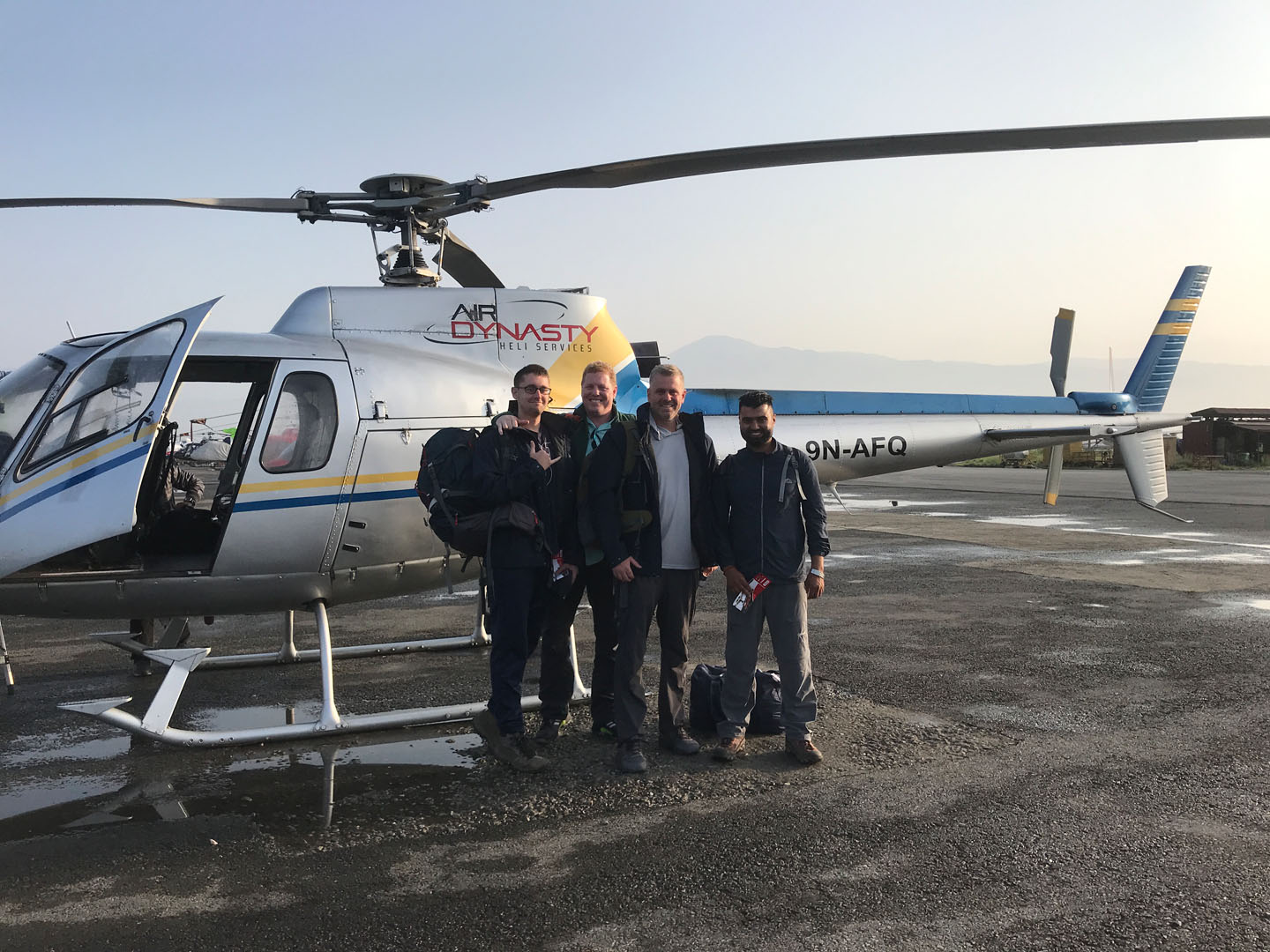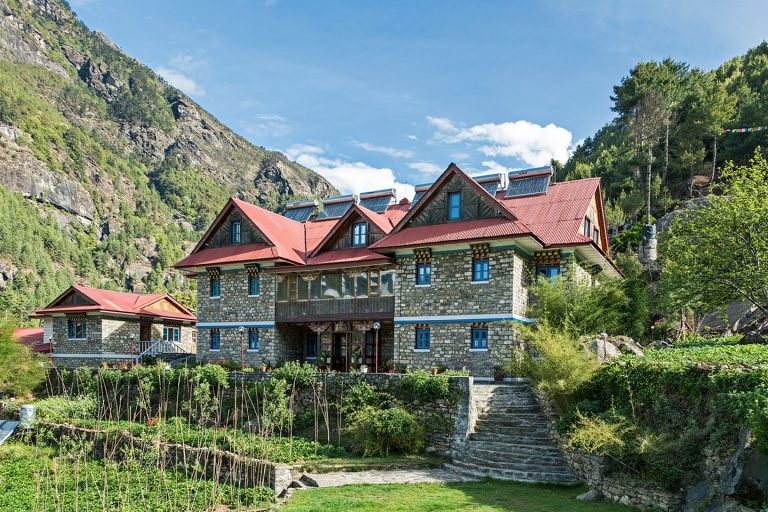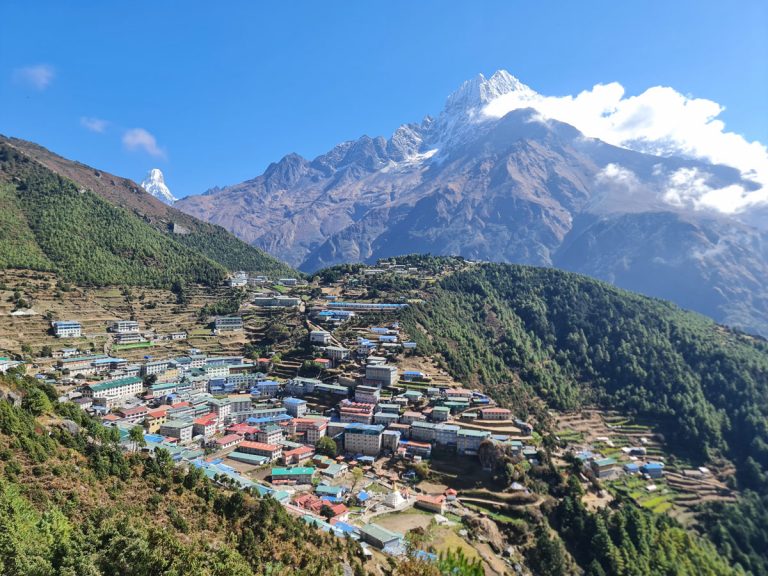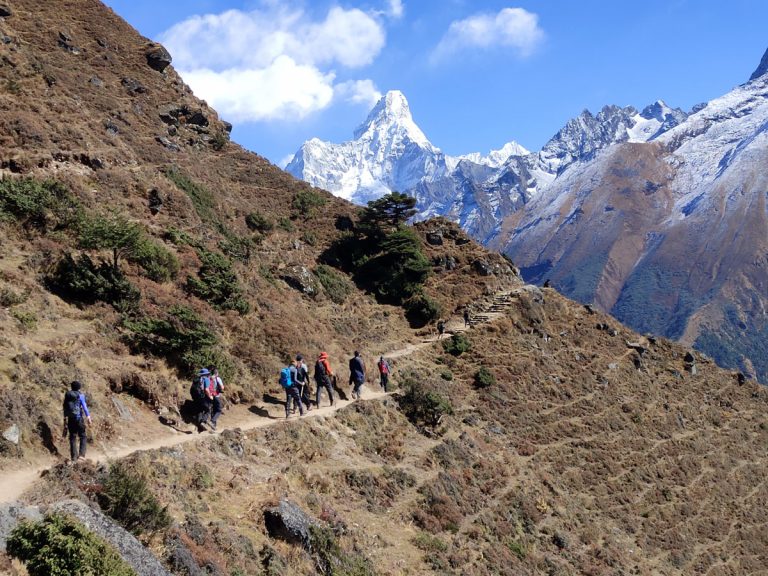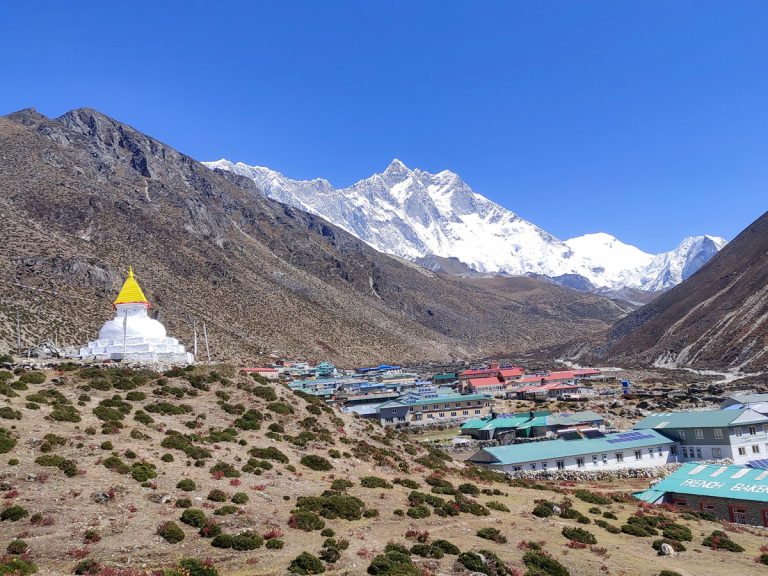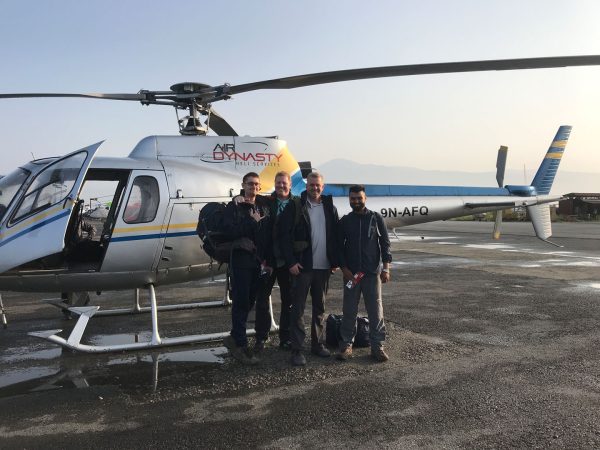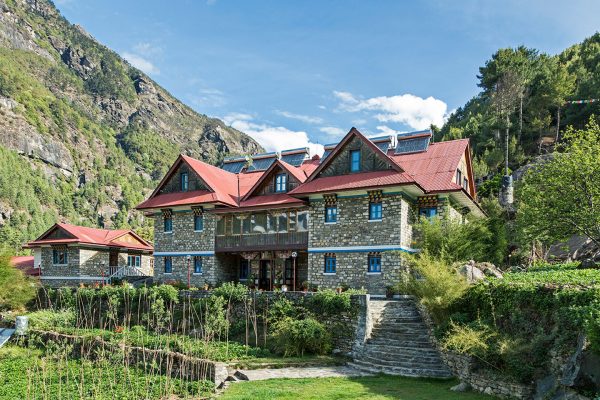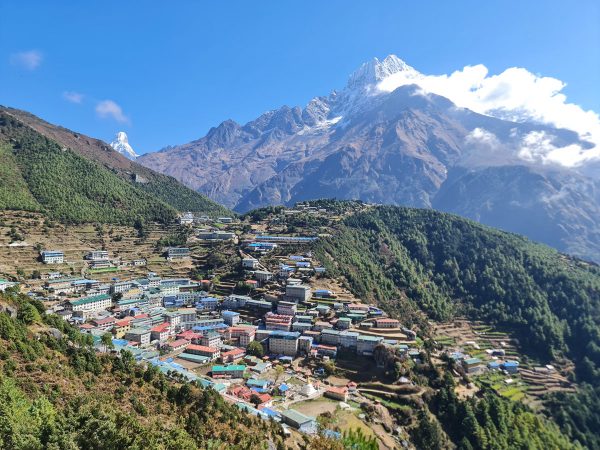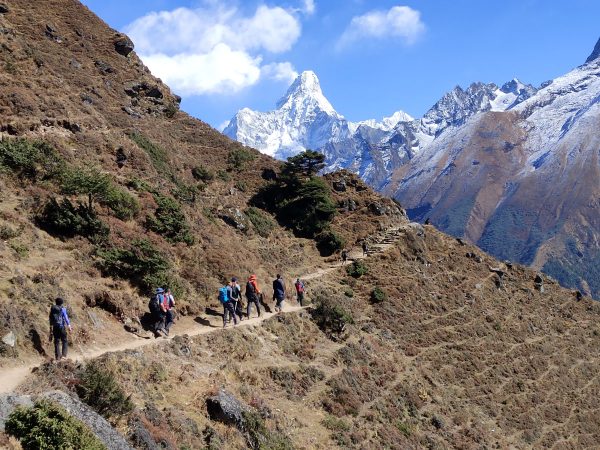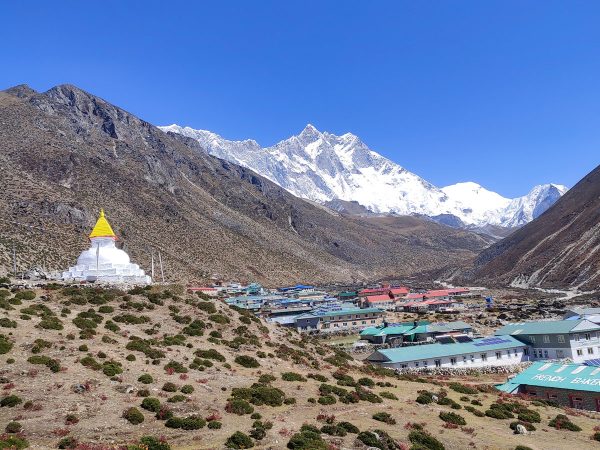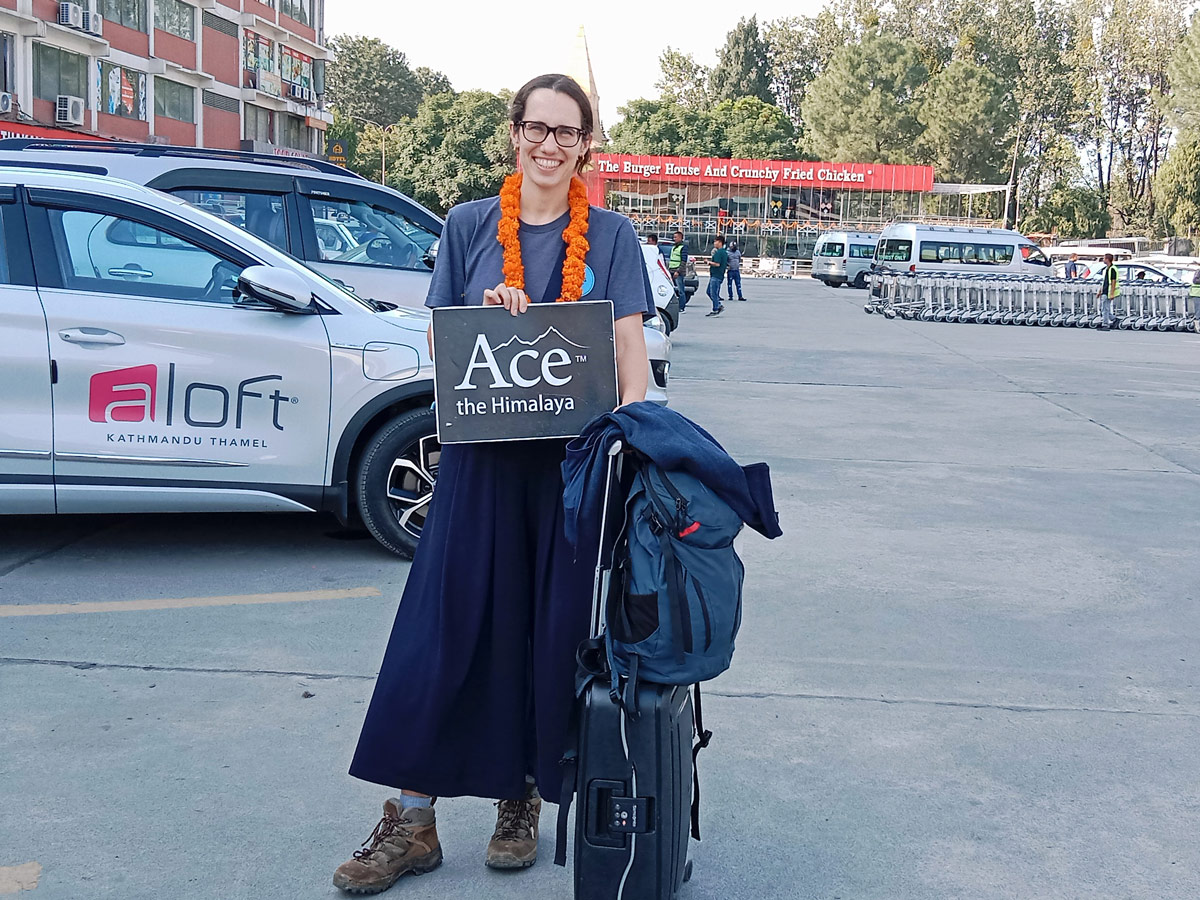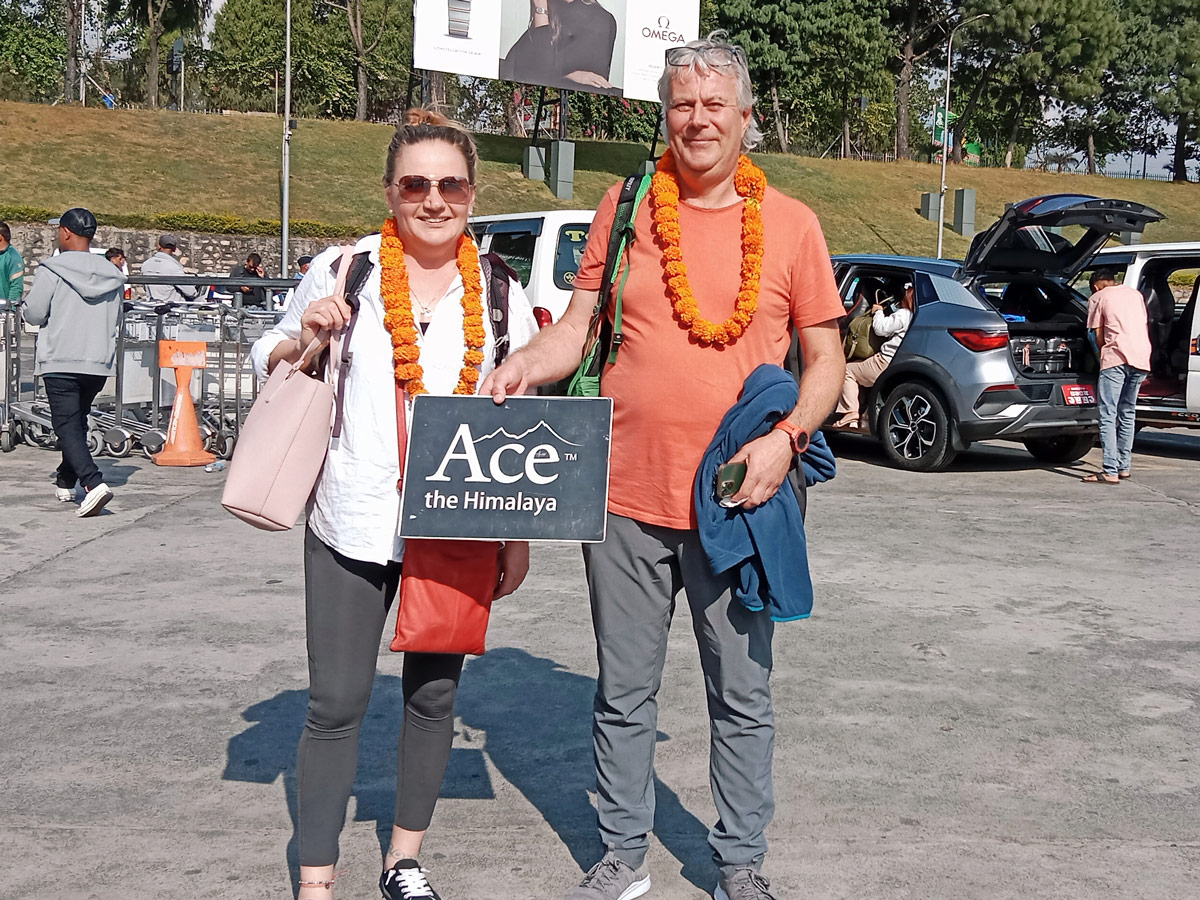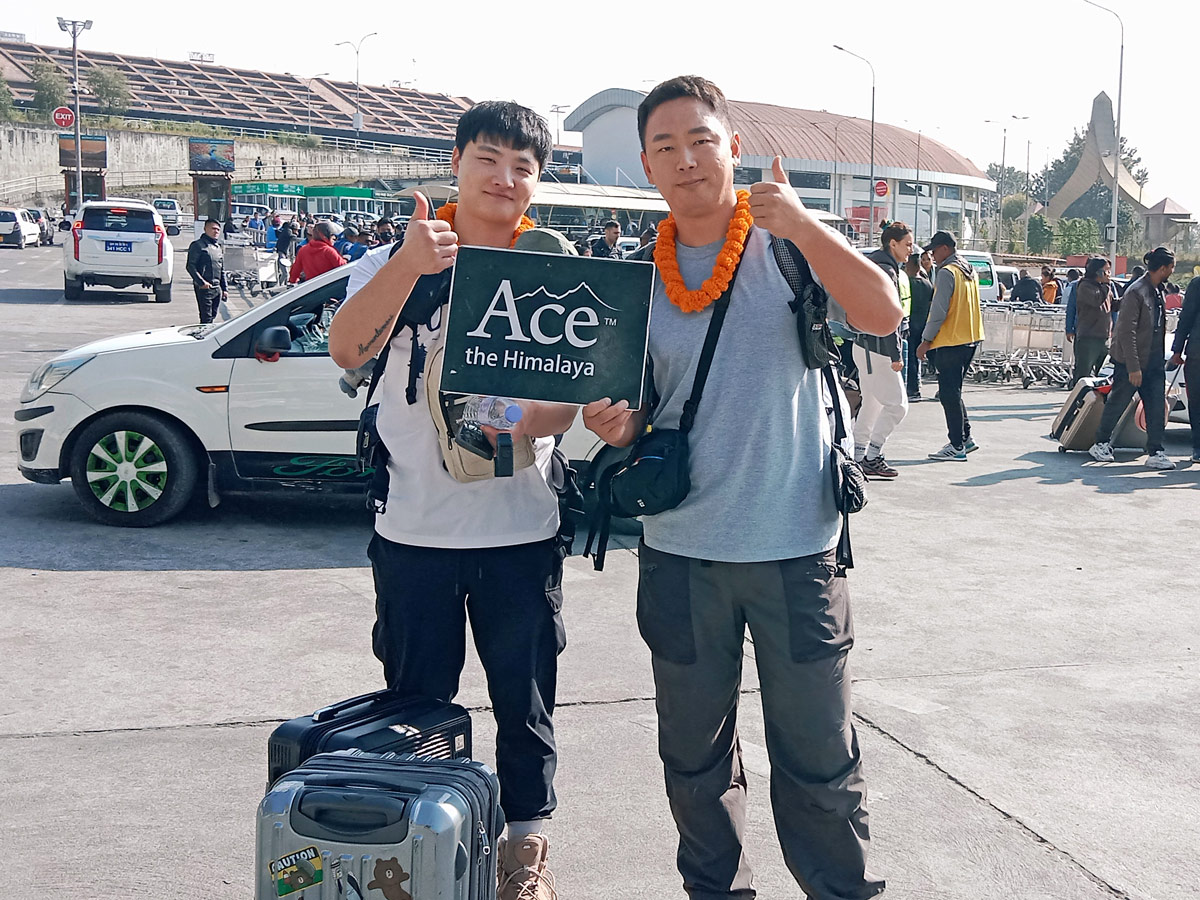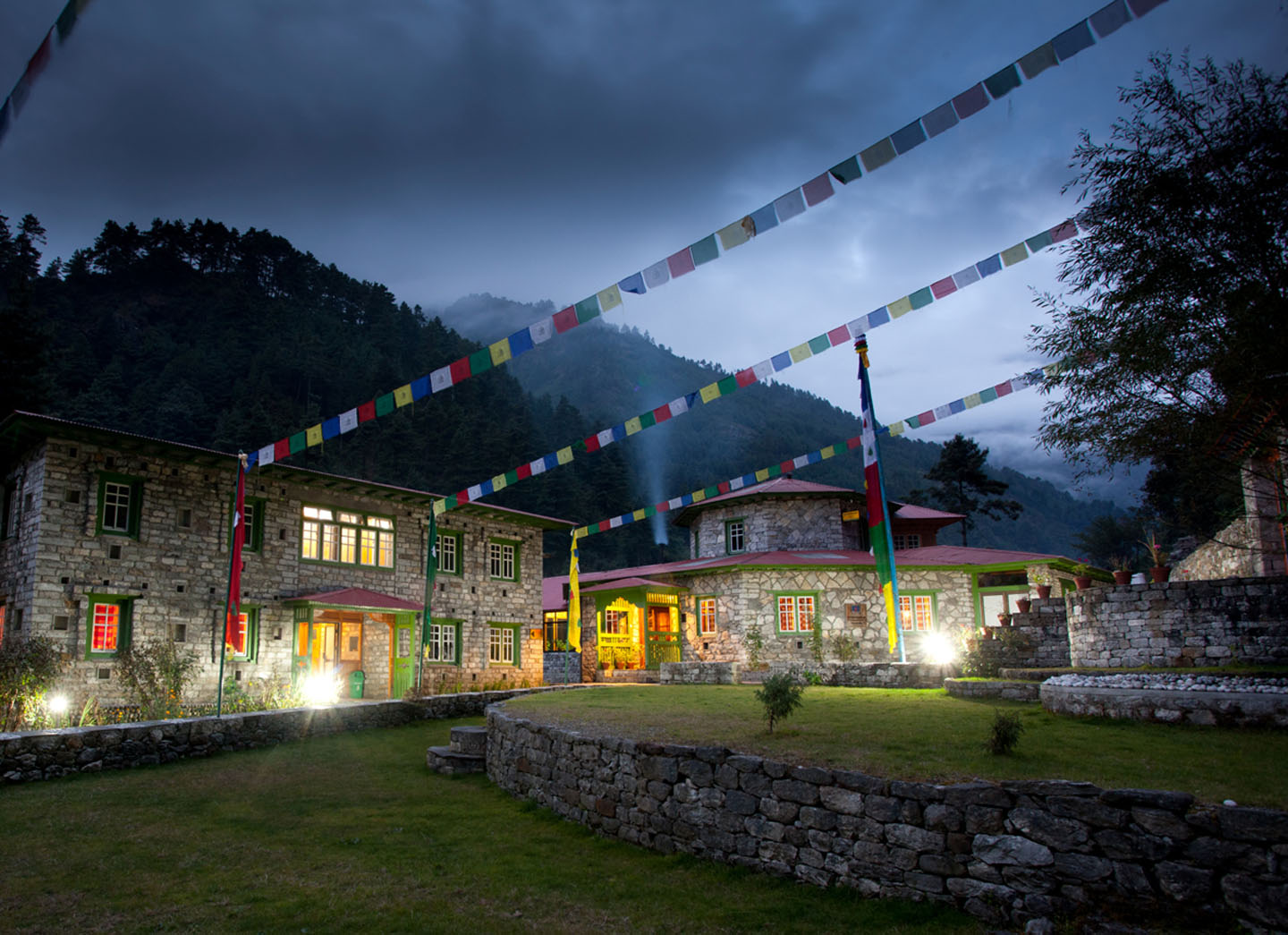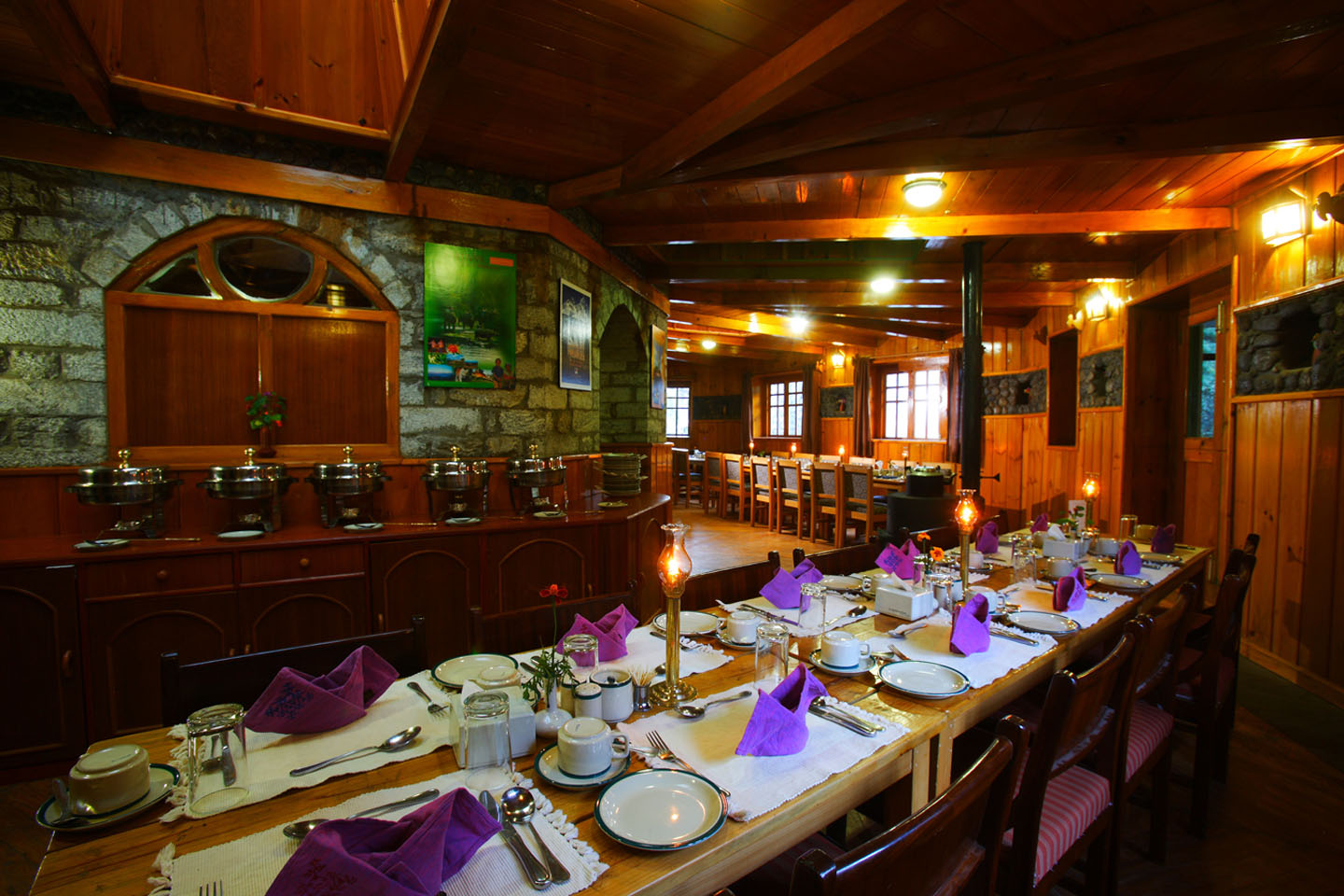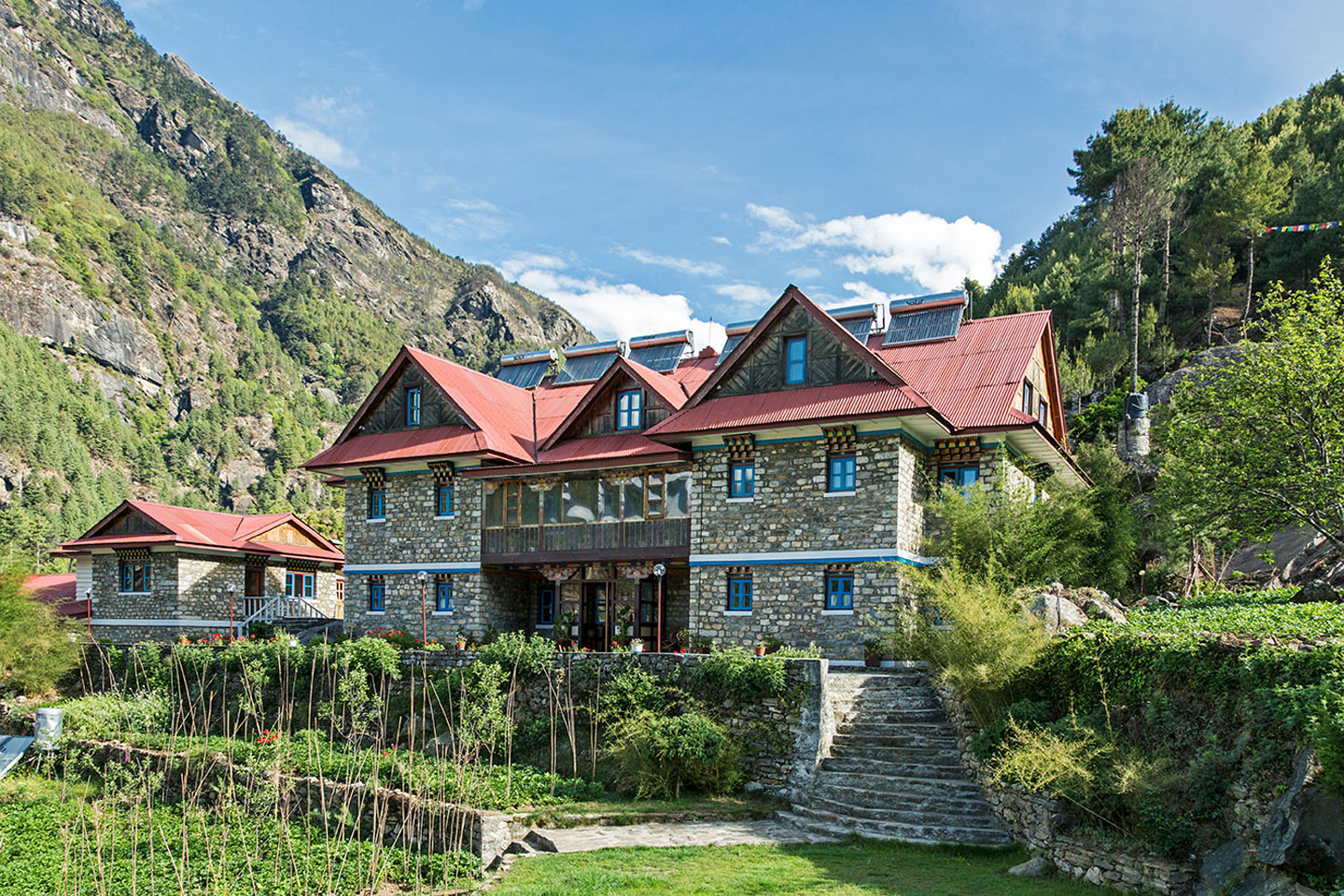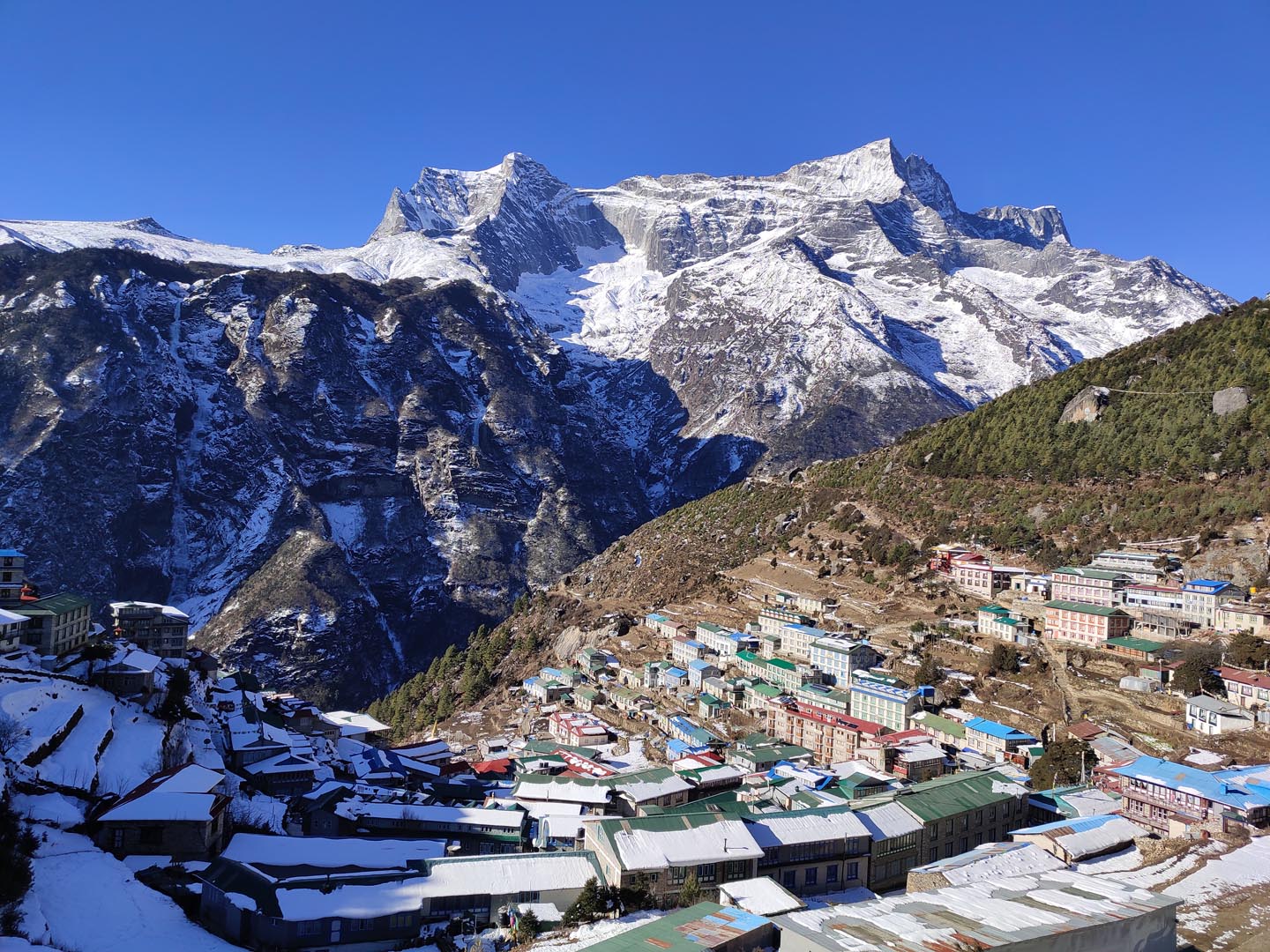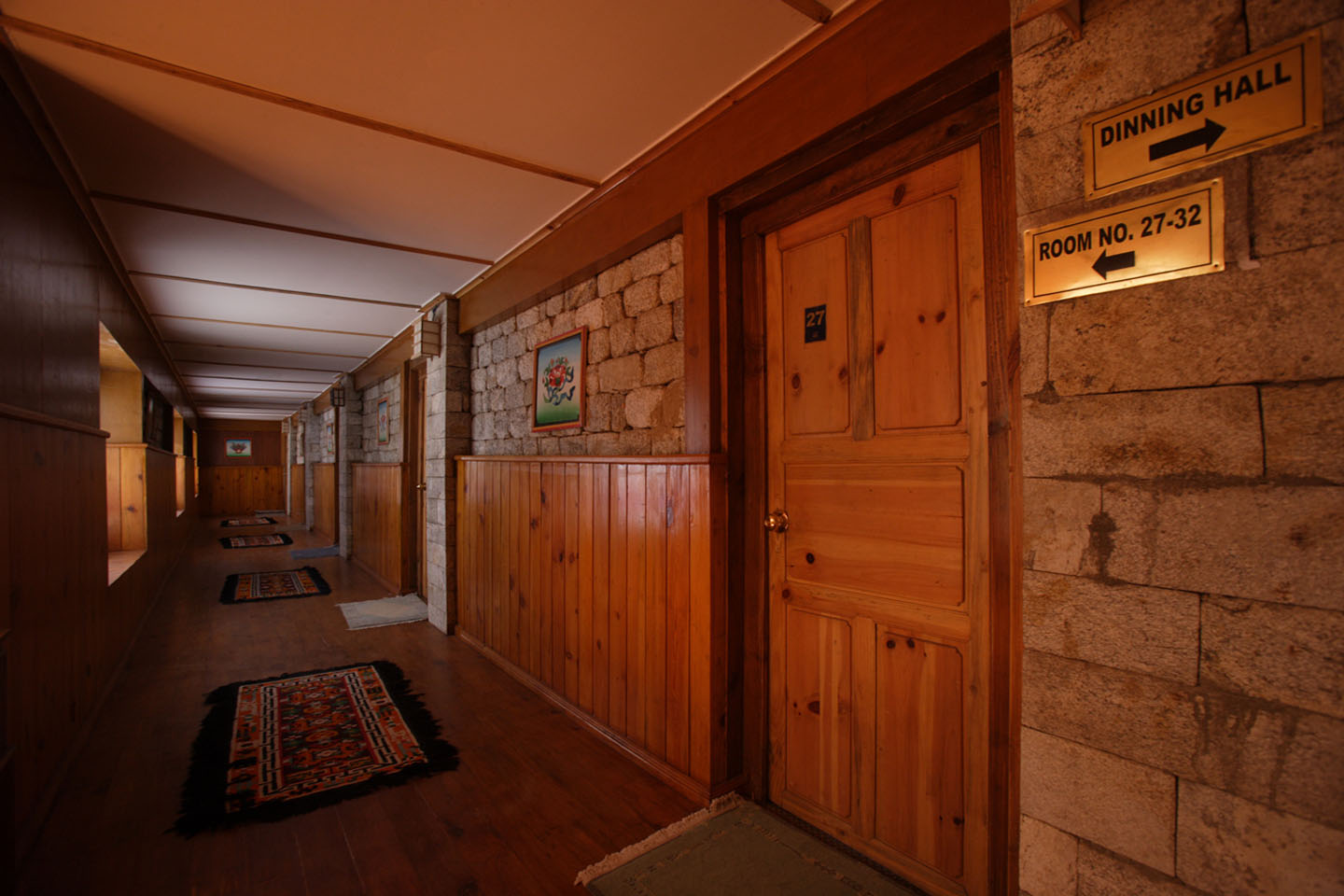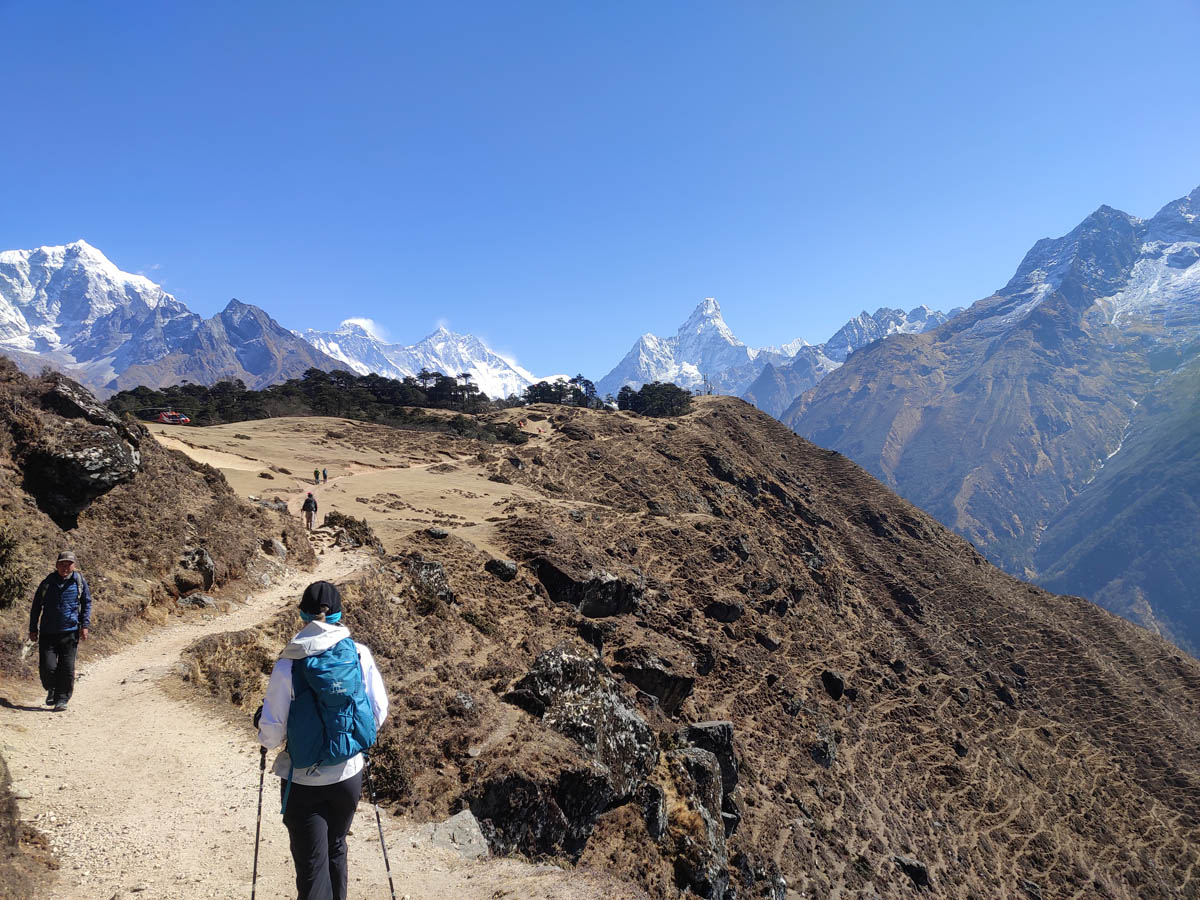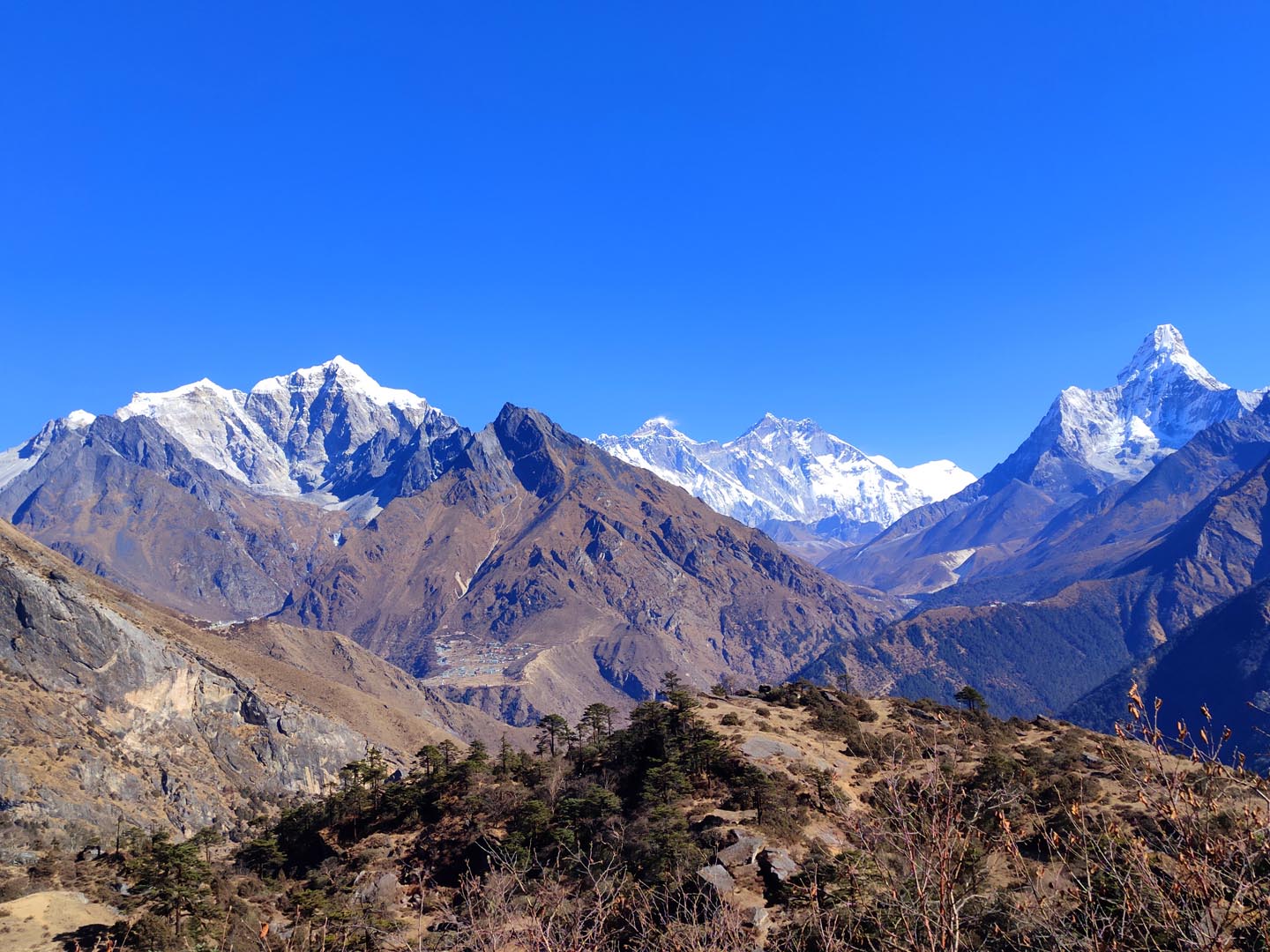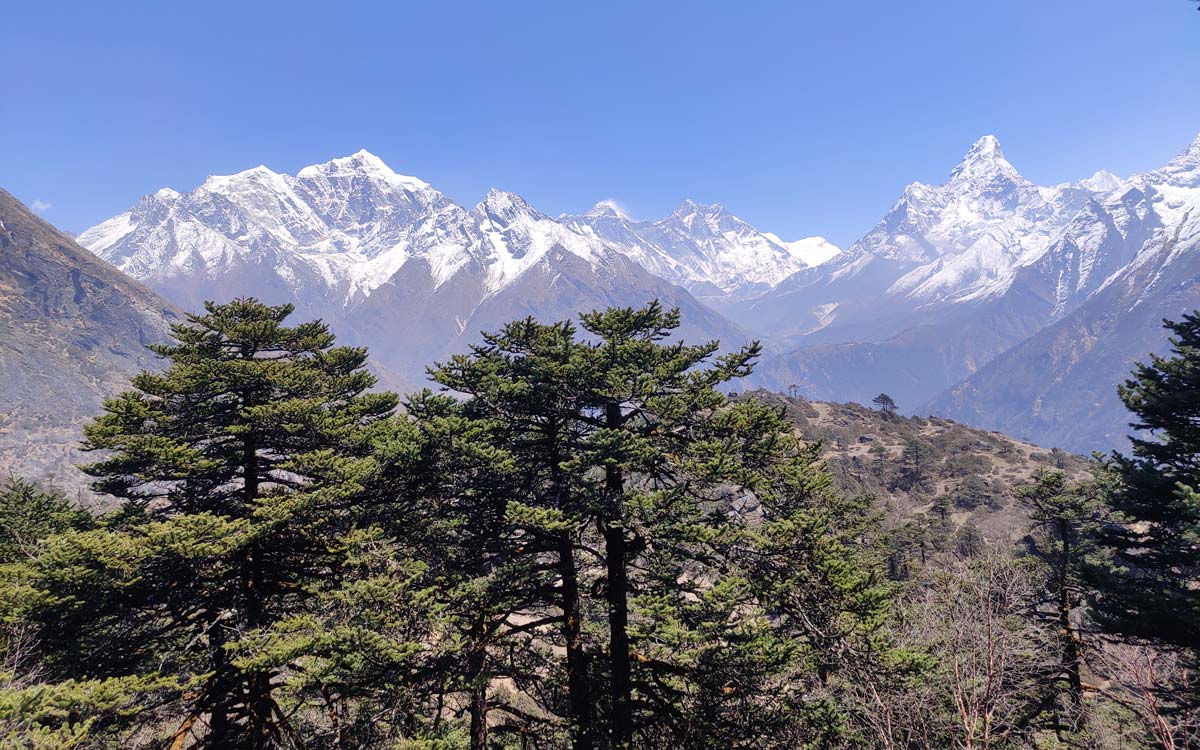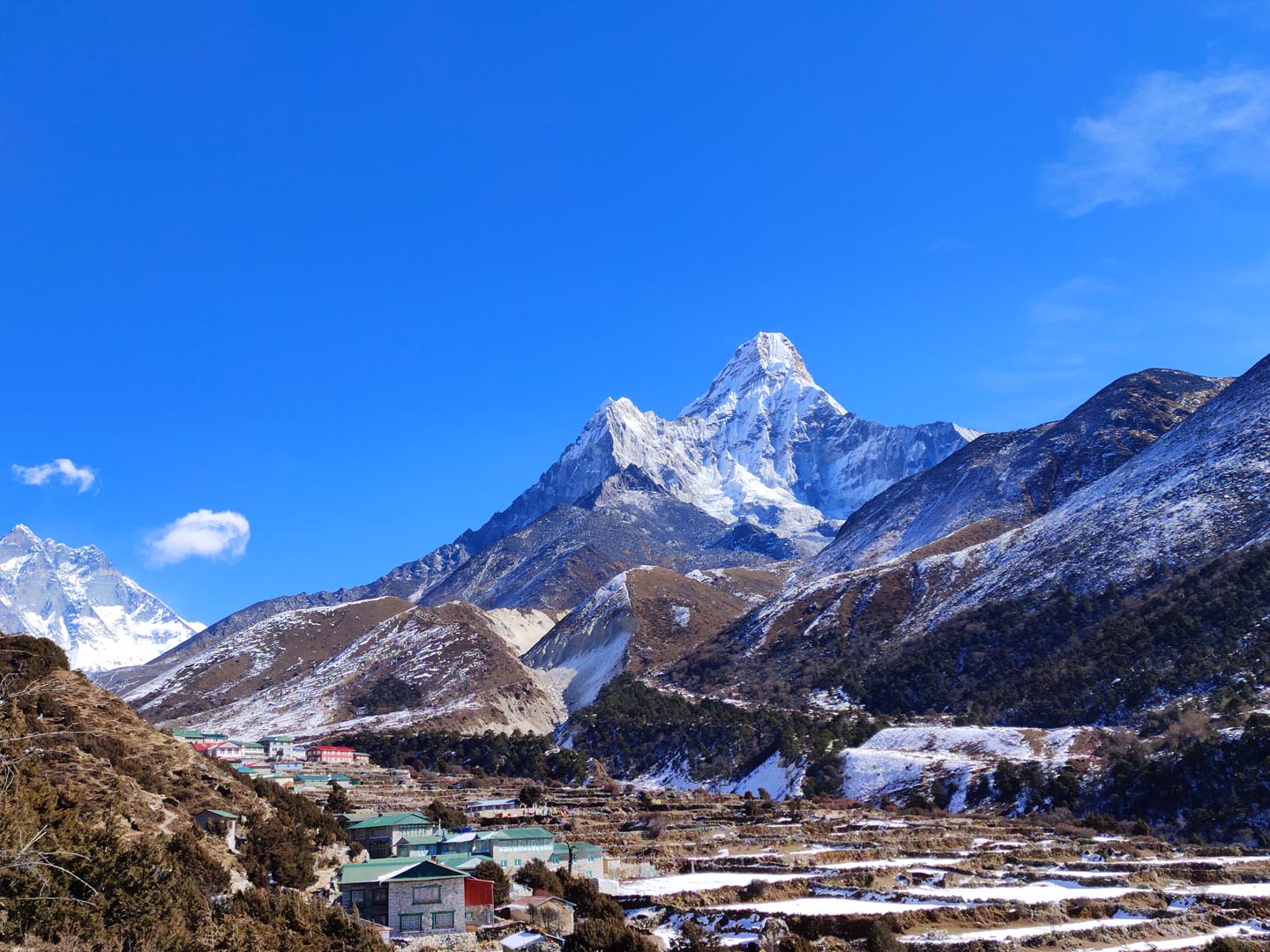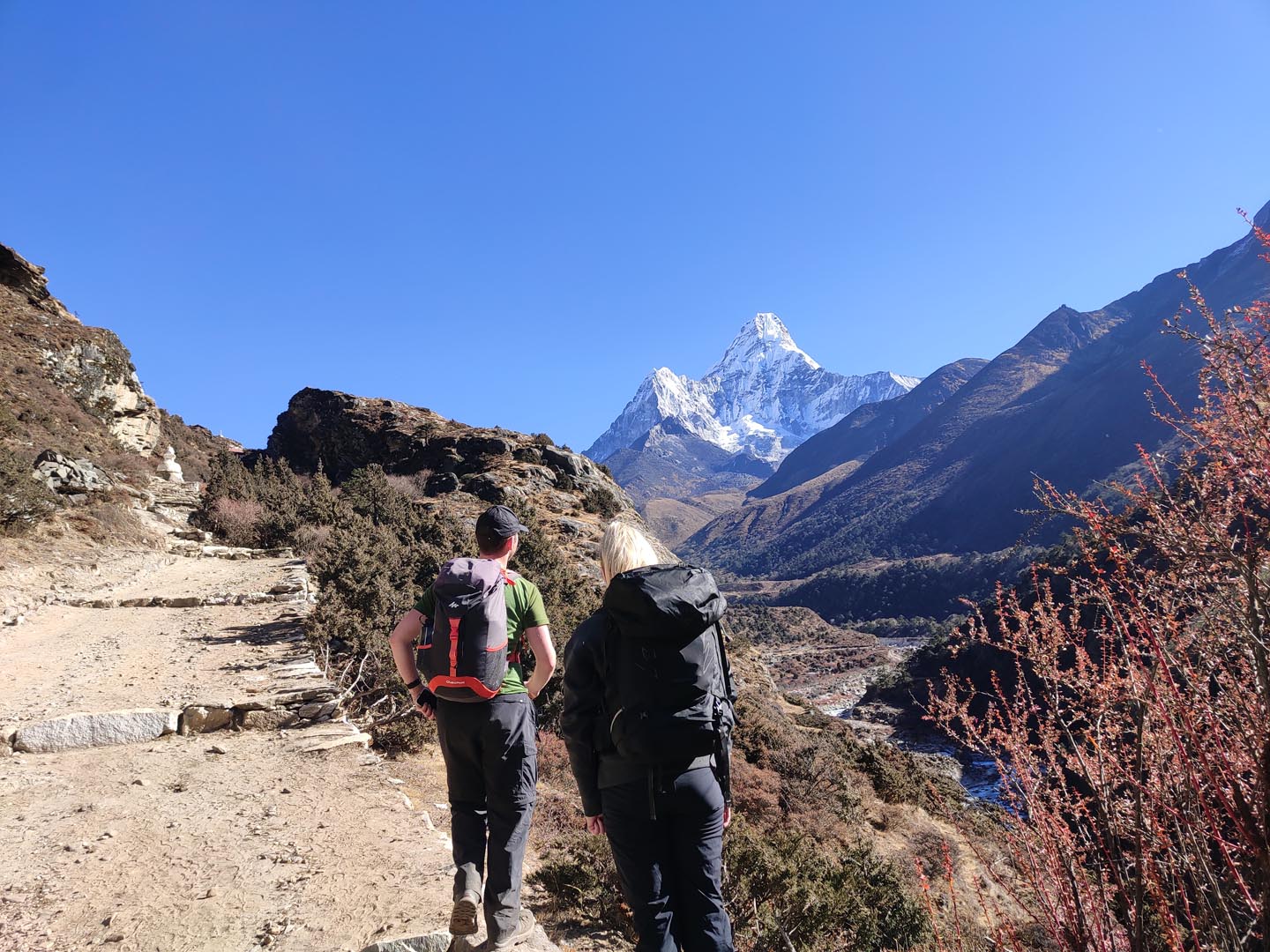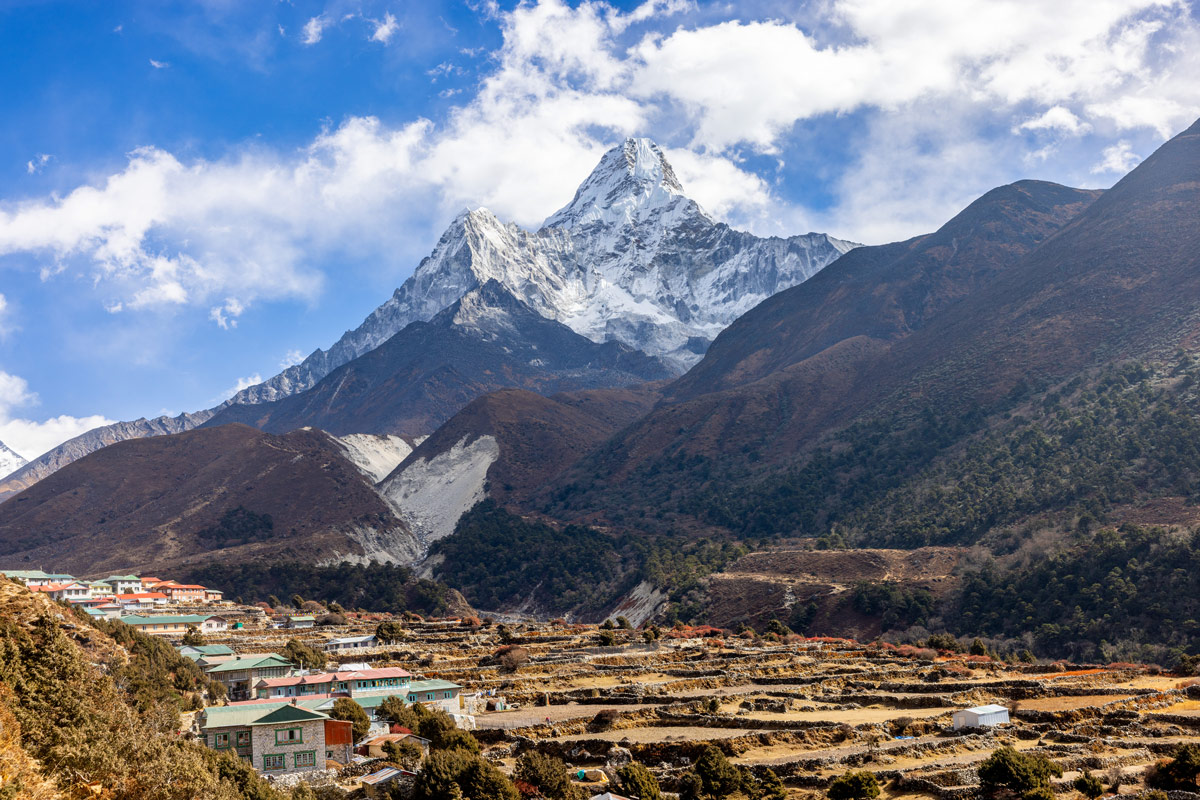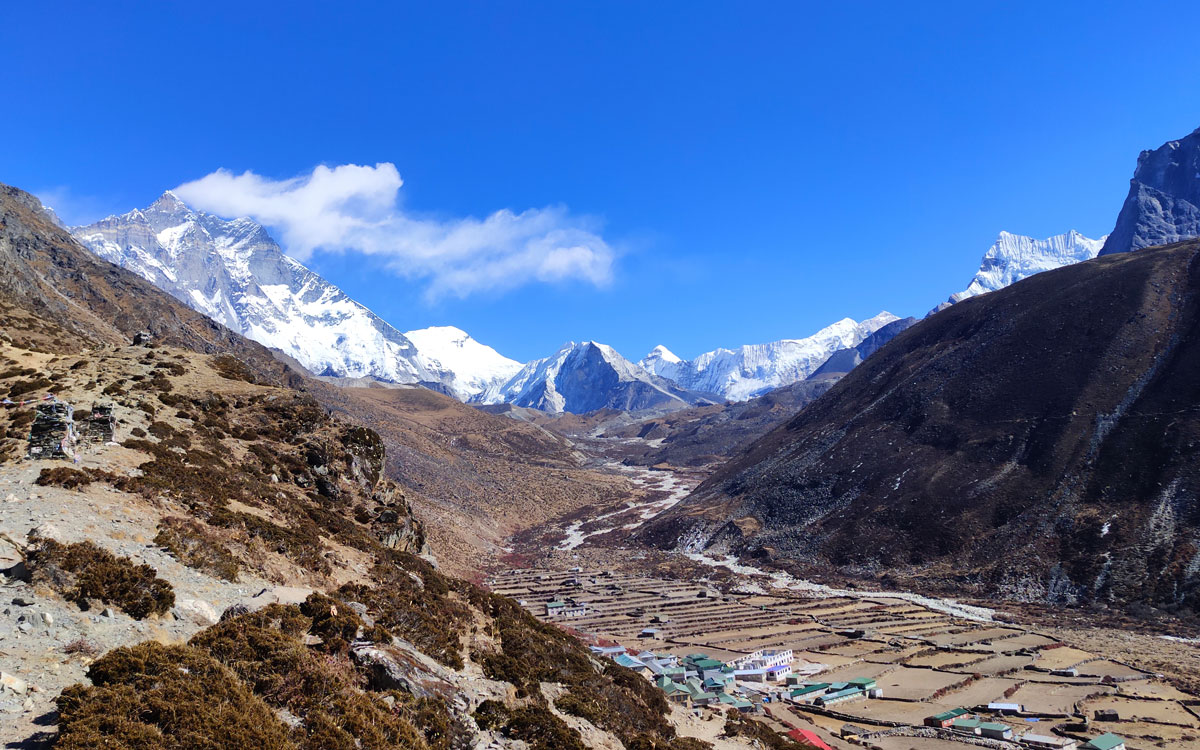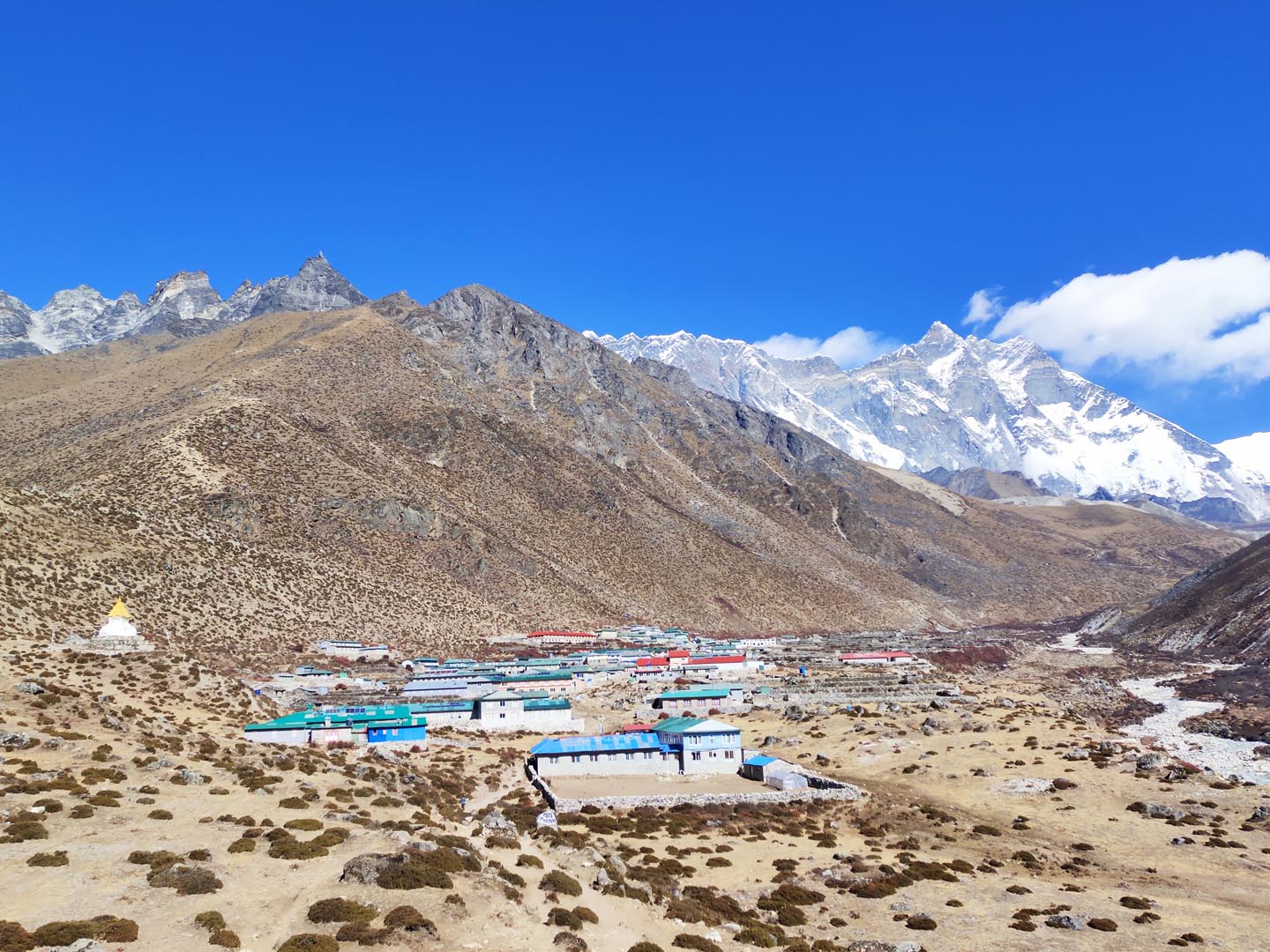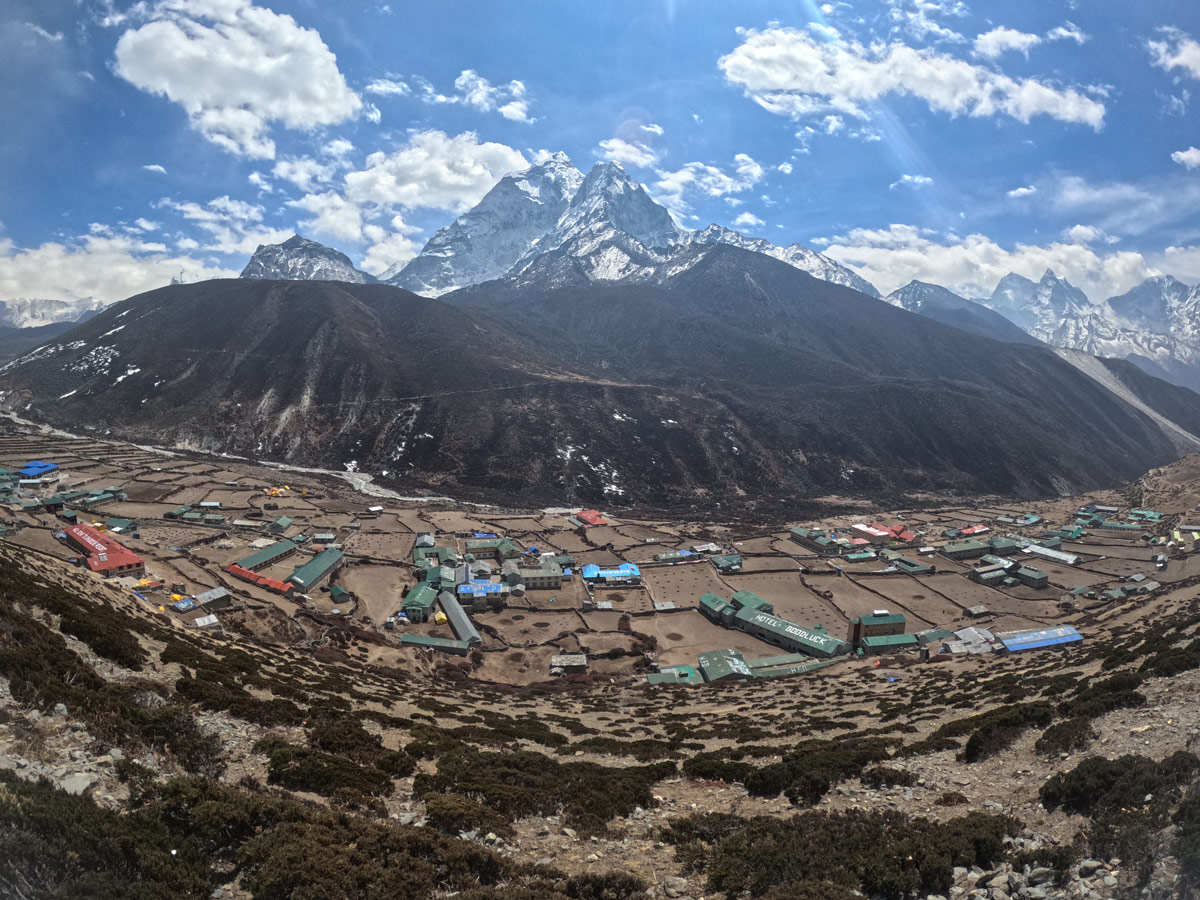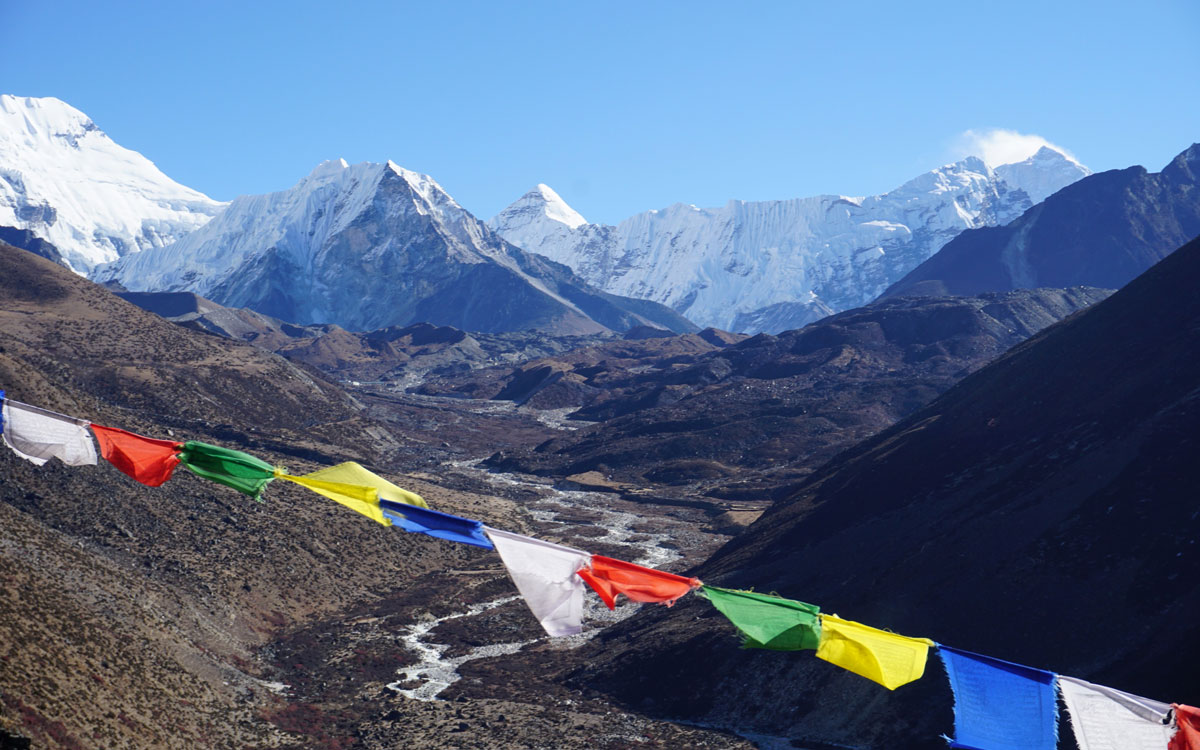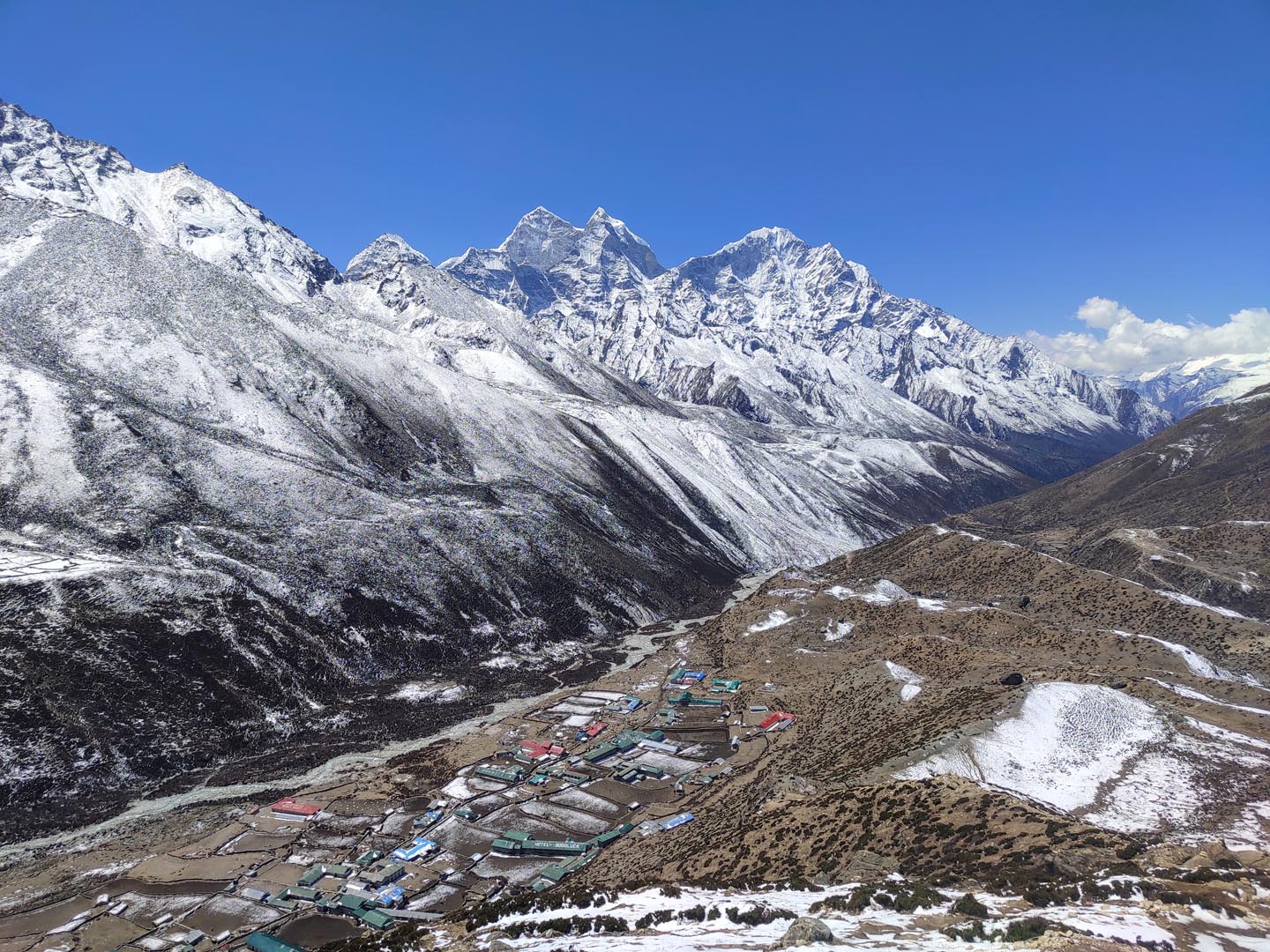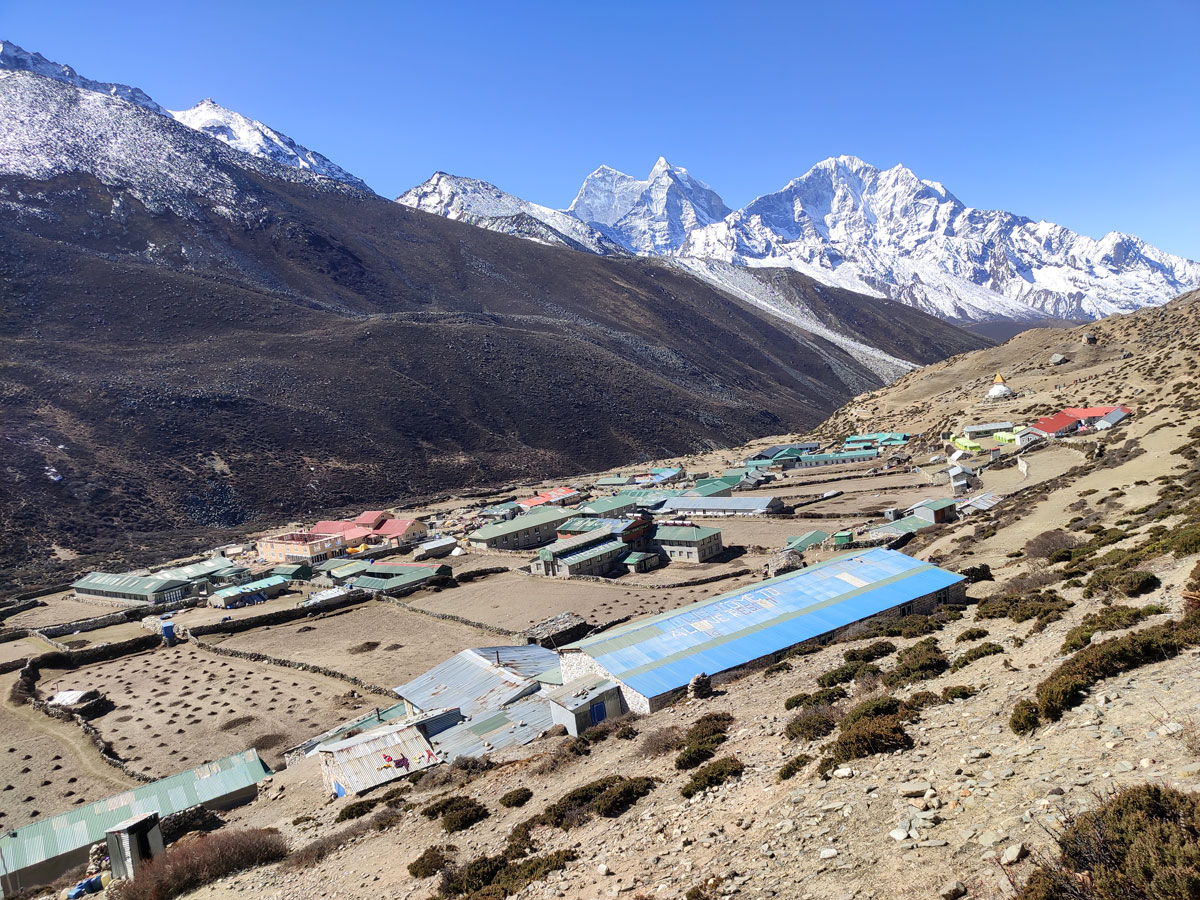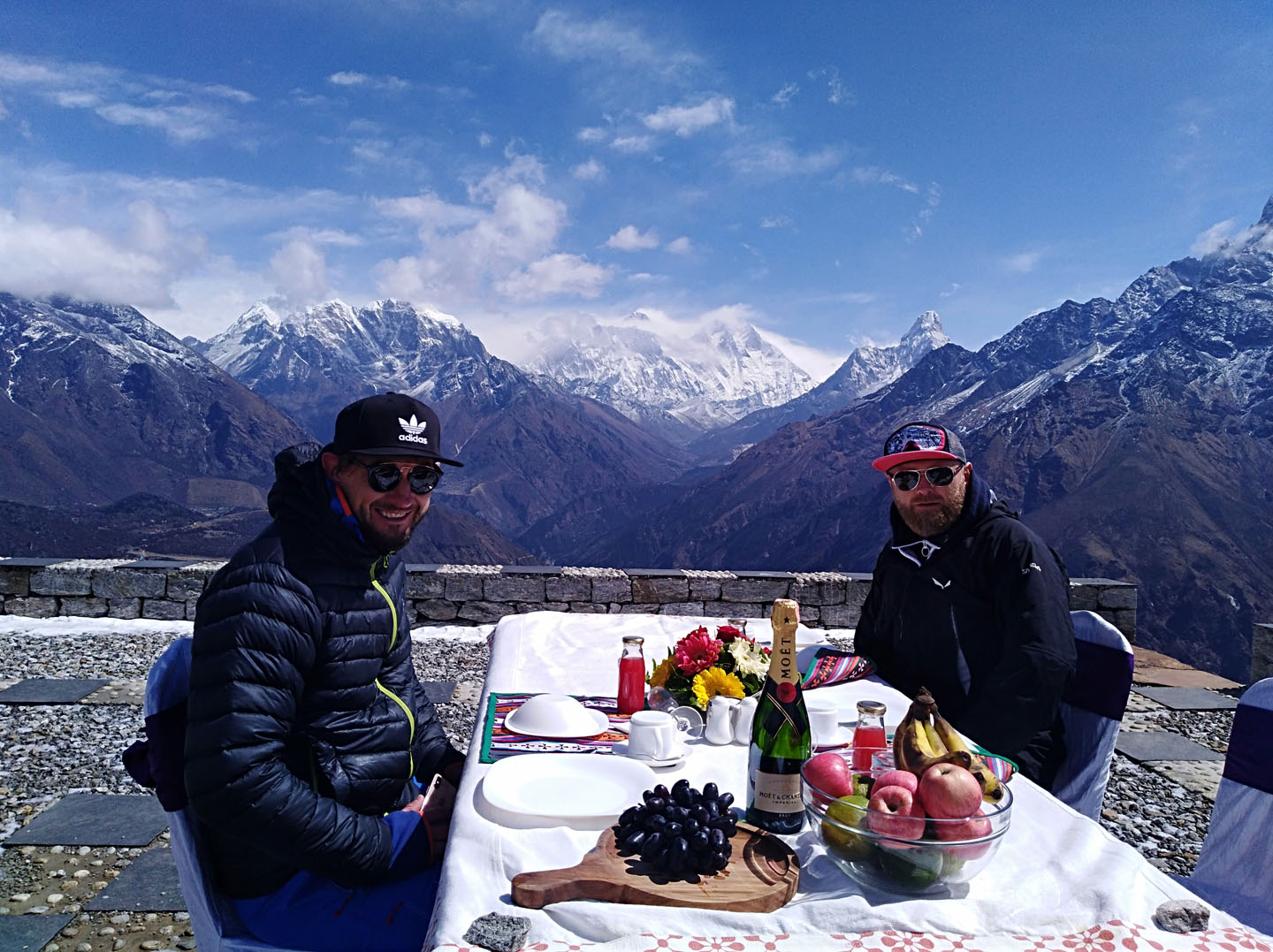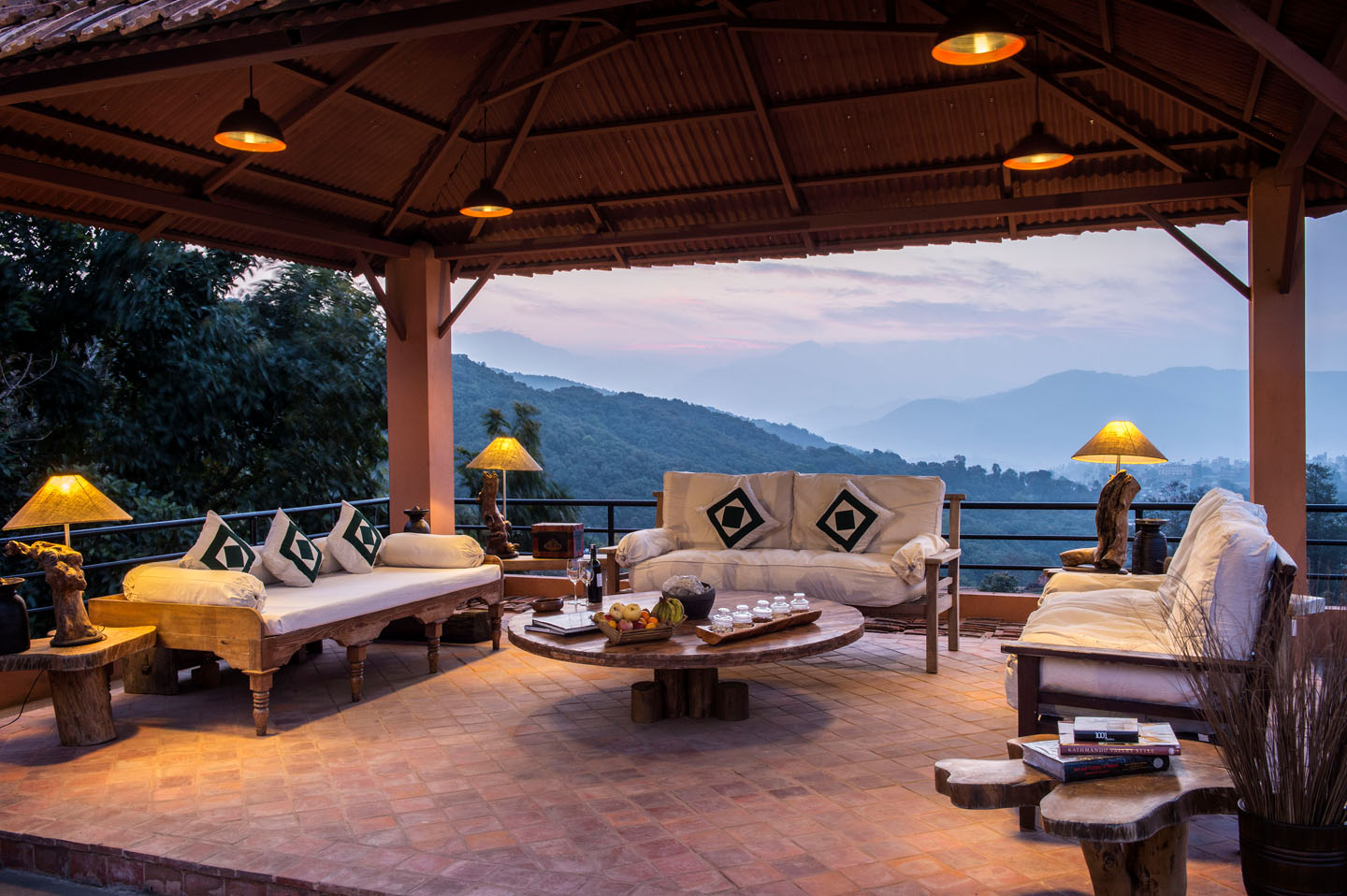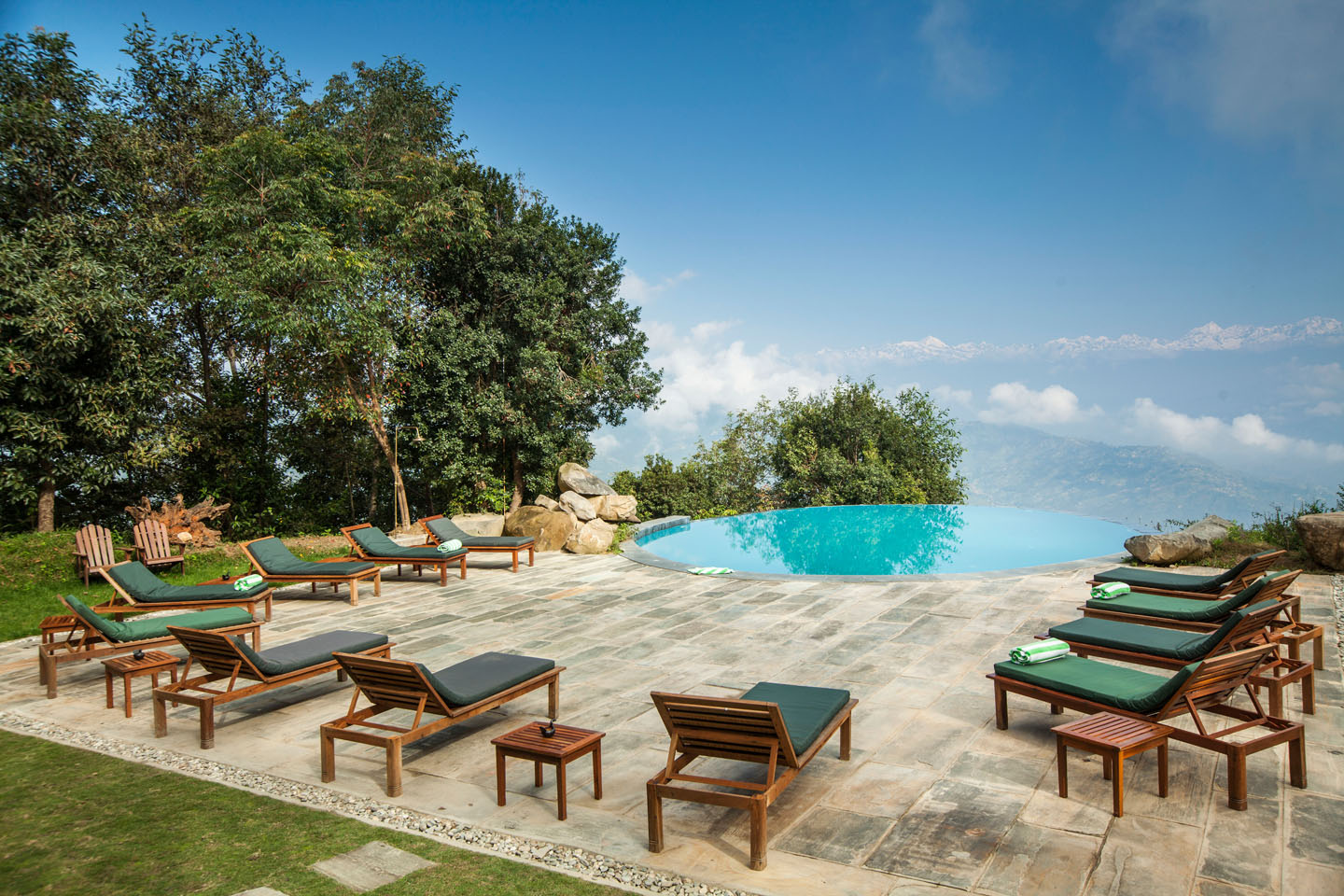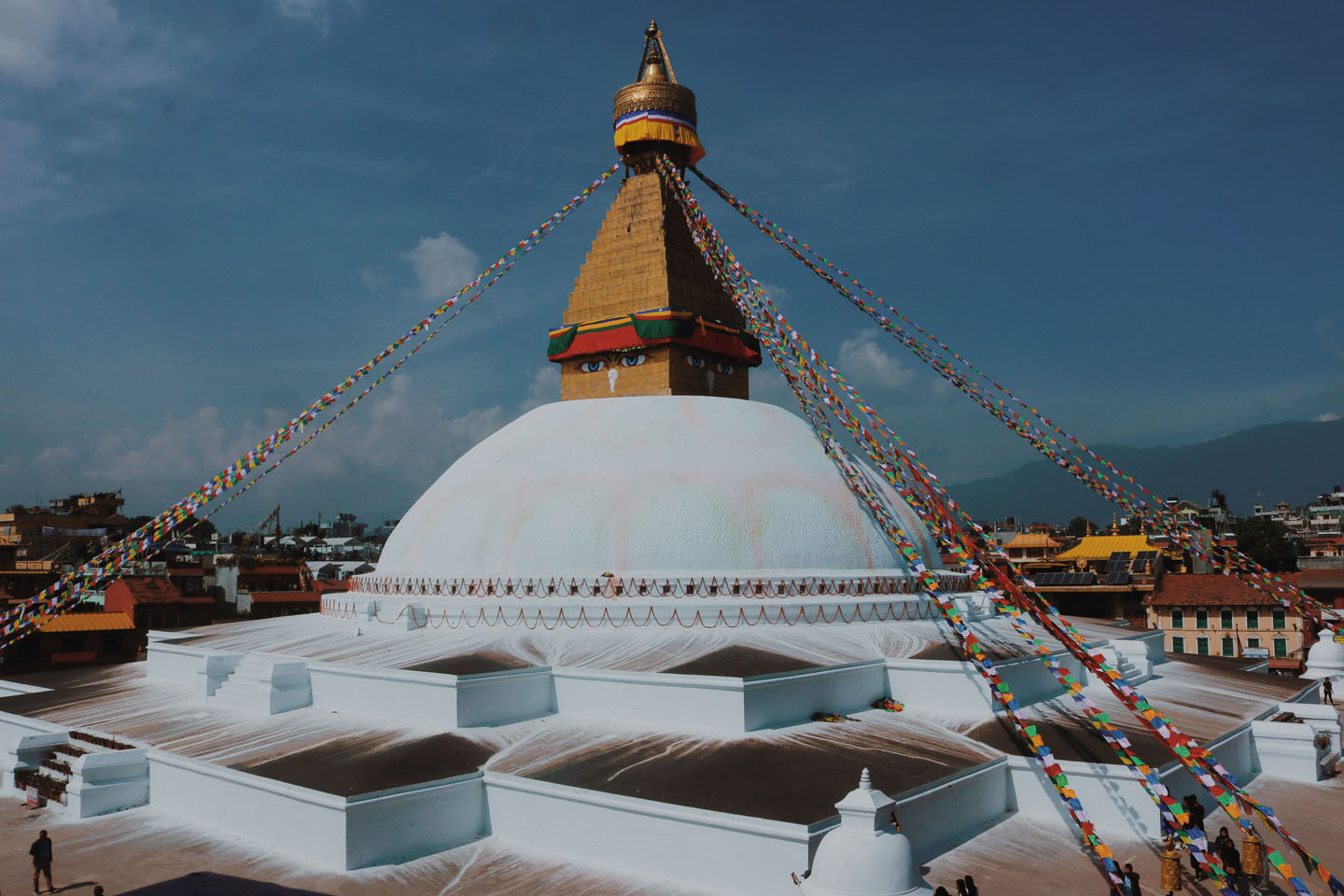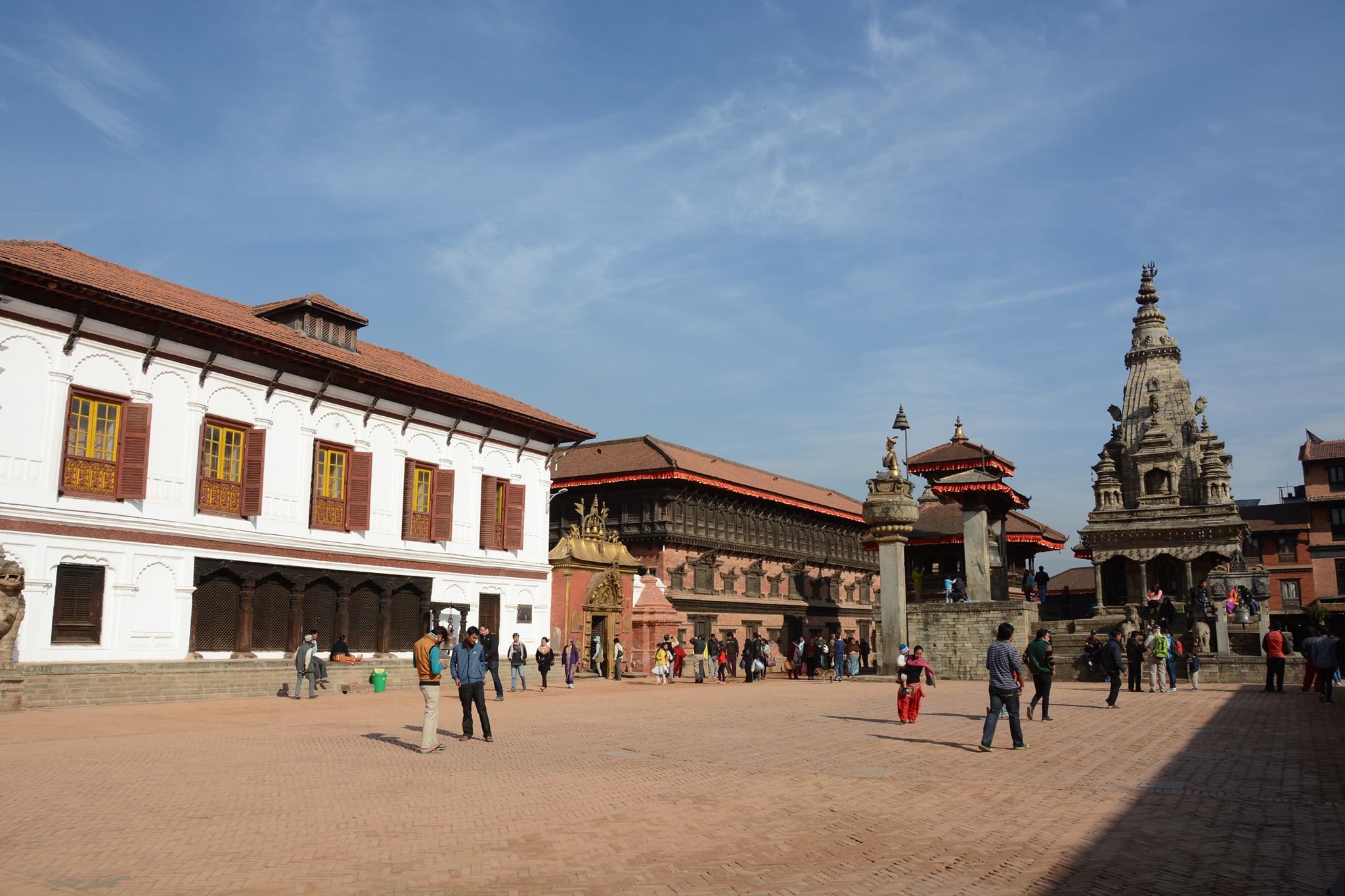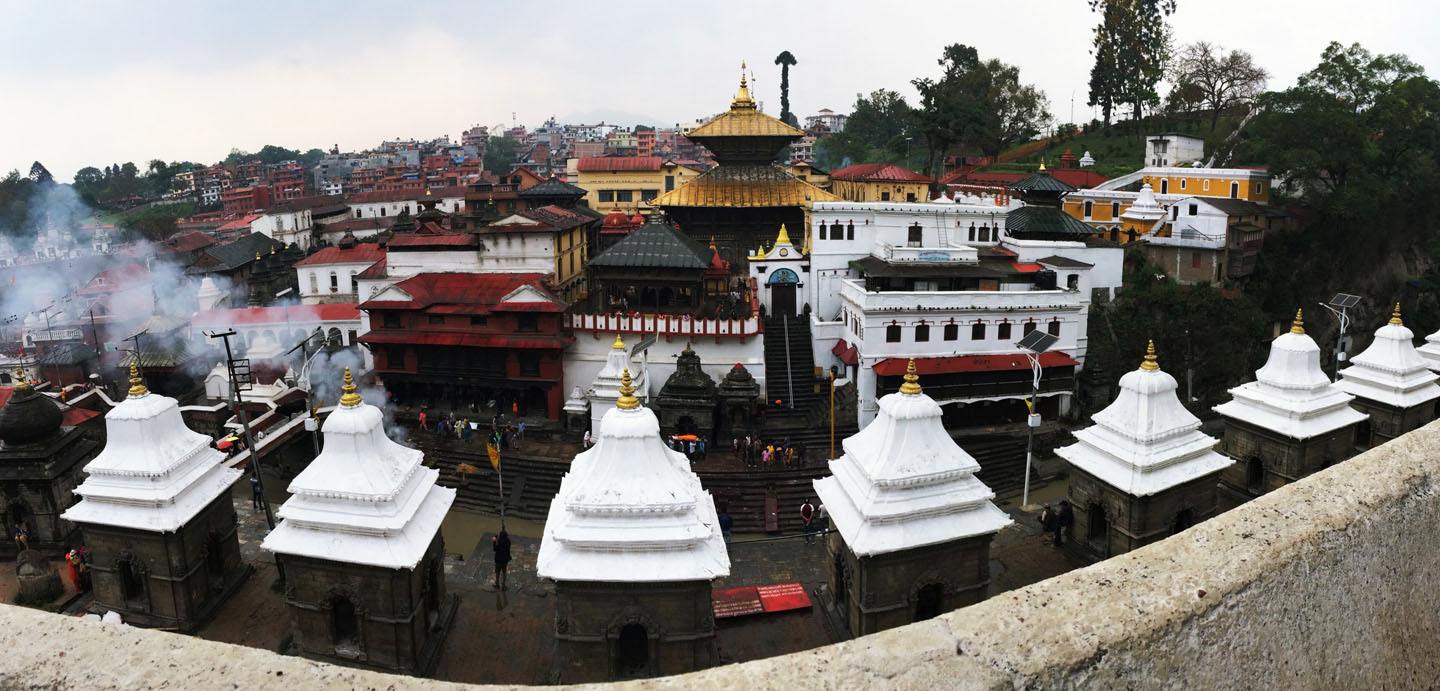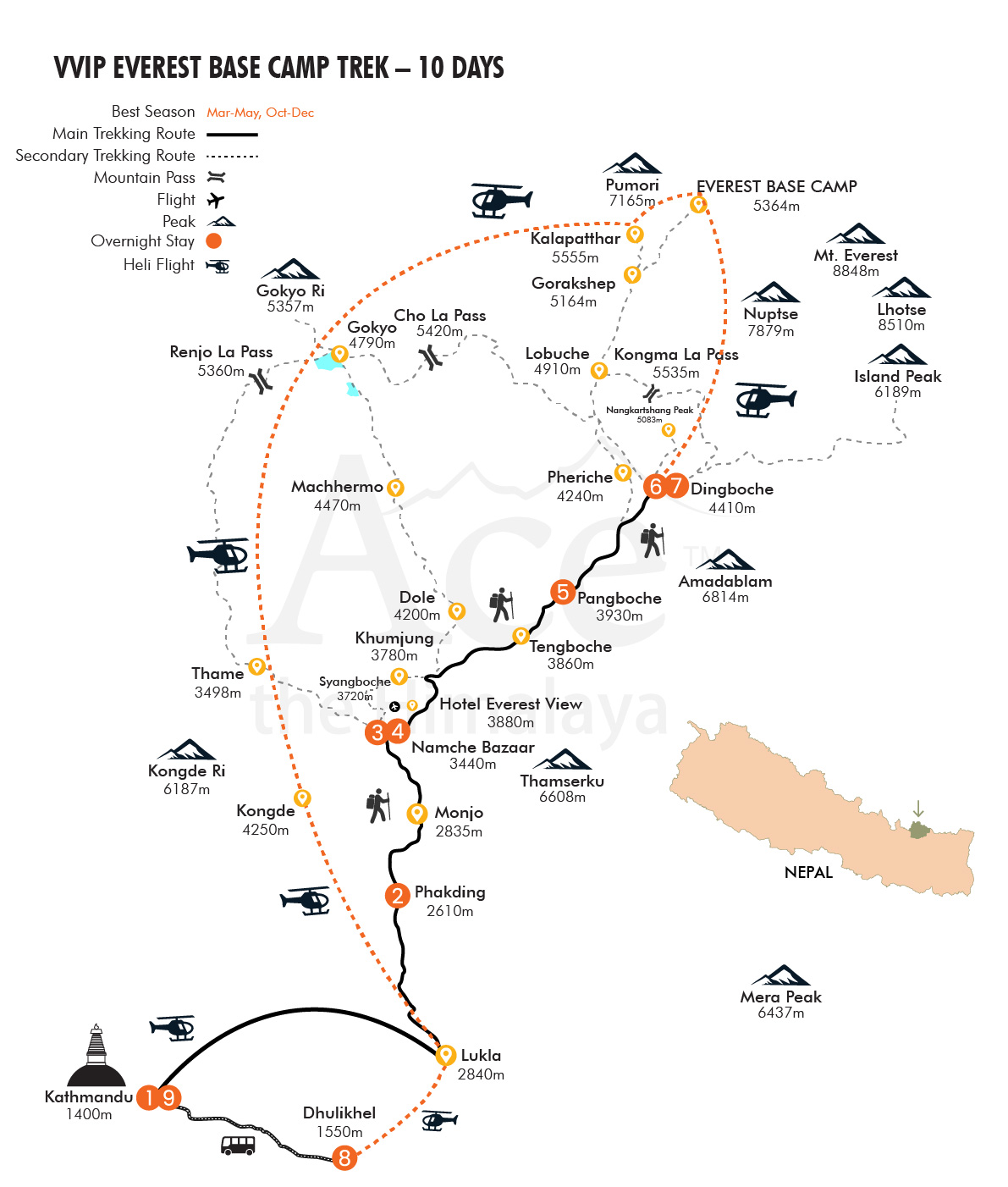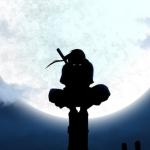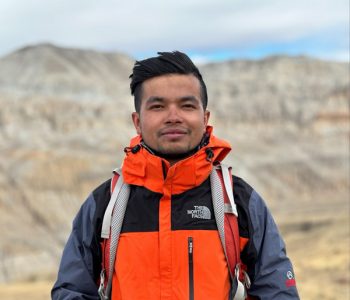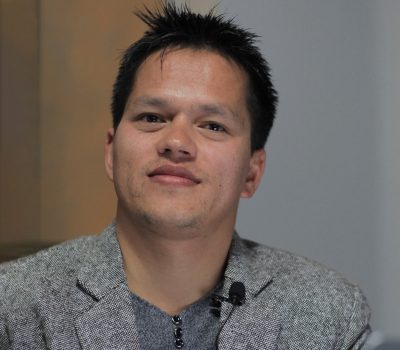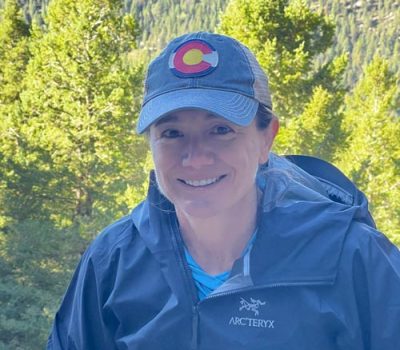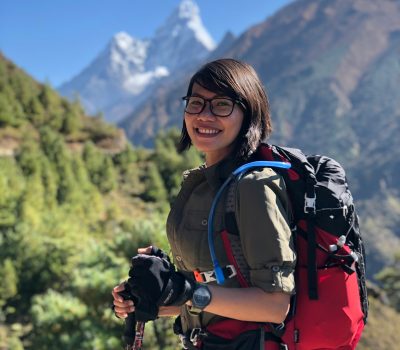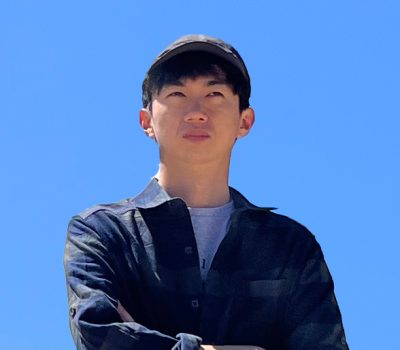VIP Everest Base Camp Trek - 10 Days
| No. of people | Price per person |
|---|---|
| Single Occupancy | USD 17,500 |
| Double Occupancy | USD 10,500 |
Experience the ultimate adventure, trekking and helicopter trip to Everest Base Camp, staying at the best luxury hotels of Everest region and Kathmandu.
EBC VIP Trek Highlights
- Trek along the legendary Everest Base Camp trail, crowned with a breathtaking helicopter flight over the majestic Himalayas.
- Enjoy the incredible aerial views of the Himalayas and Gokyo Valley in the comfort of a helicopter flight.
- Catch breathtaking views of Mount Everest, Lhotse, Nuptse, Thamserku, Ama Dablam, Cho Oyu and associated peaks.
- Experience luscious lunch with champagne overlooking panoramic Himalayan peaks at Mountain Lodges of Nepal, Kongde.
- Enjoy your luxurious accommodation at the best hotels in Kathmandu and Everest region.
- Hike to Nangkartshang Peak (5,083 m), offering spectacular views of the surrounding landscapes.
- Revel in the warm welcoming hospitality and unique culture of native Sherpas.
- Explore three major UNESCO World Heritage Sites in the Kathmandu Valley.
- The entire sojourn is managed and communicated by the company’s GM/CEO.
Trip Overview
Imagine touring around the majestic Himalayas, in the shadow of the world’s highest mountain, the iconic mighty Mount Everest (8,848 m/29,029 ft), and the whole Khumbu region surrounded by a crown of the world’s most breathtaking peaks.
An epic adventure where every moment of your journey seamlessly blends with unparalleled luxury. Embark on the most exclusive VIP Everest Base Camp Trek, where adventure meets luxury in the heart of the Himalayas.
This lavish EBC trekking experience combines breathtaking landscapes, world-class hospitality, and unparalleled comfort, ensuring an unforgettable journey to the world’s highest peak.
Your experience begins in Kathmandu, where you’ll unwind in the refined elegance of 5-star accommodations like the Dwarika’s Hotel. You will be immersed in deluxe suites and gourmet dining, setting the tone for the journey that lies ahead.
From here, a private helicopter soars over the Himalayan region, swiftly carrying you straight to Lukla (2,860 m/9,383 ft), bypassing the usual city crowds and offering breathtaking aerial views of the Himalayas.
Upon thrilling landing, you’ll be welcomed into the Everest region’s finest luxury lodges, where warm Sherpa hospitality blends seamlessly with high-end comforts.
Your accommodation features picture-perfect fireplaces, sumptuous bedding, and exquisite meals tailored to your taste, all set against a backdrop of lush landscapes and towering snow-capped peaks.
The EBC luxury trek itself is a masterpiece of curated experiences. It unveils the spectacular beauty of the Khumbu Valley and the Everest region in unparalleled style.
You’ll hike through Sagarmatha National Park, where you will traverse serene mani walls, listen humming of sacred chants, pass ancient monasteries draped in prayer flags, and explore vibrant Sherpa villages including Phakding, Namche Bazaar, Pangboche, Tengboche, and Dingboche, each resting stops rich in culture and history.
Throughout the journey, you’ll be rewarded with stunning mountain vistas, including Kusum Kangkaru (6,367 m/20,889 ft), Thamserku (6,608 m/21,680 ft), Kongde Ri (6,187 m/20,298 ft), Ama Dablam (6,812 m/22,349 ft), Nuptse (7,861 m/25,791 ft), and Lhotse (8,516 m/27,940 ft).
Yet, this is no ordinary trek, you will find it’s a seamless blend of adventure with luxury accommodation and available opulent facilities.
When the trail steepens from Dingboche, your private helicopter awaits to elevate you to thrilling Everest Base Camp and spectacular Kala Patthar- the most popular vantage points in Everest region.
After immersing in the serene Himalayan landscapes, a truly magnificent highlight. You will be soaring over the turquoise Gokyo Lakes, one of the highest freshwater glacial lakes in the world.
Your journey continues with an exclusive landing at Mountain Lodges of Nepal, Kongde, where a gourmet lunch paired with vintage champagne awaits, offering a dining experience like no other- with the majestic Himalayas as your backdrop.
After a hearty lunch in Kongde, soaking in the awe-inspiring mountain views and gazing at serene Namche Bazaar from a distance, you retreat to Dwarika’s Resort in Dhulikhel (1,470 m/4,822 ft).
Discover timeless luxury at Dwarika’s Resort, a haven of serenity with panoramic Himalayan views, where every detail from the exquisite linens to the locally sourced cuisine speaks of quiet luxury and authentic hospitality.
En route back in Kathmandu, immerse yourself in the spiritual and cultural heartbeat of Nepal with private tours of UNESCO World Heritage sites including Pashupatinath Temple, Boudhanath Stupa, and Bhaktapur Durbar Square.
Throughout your journey, expert guides and 24/7 helicopter support you ensuring safety and seamless transitions, while every meal, accommodation, and transfer reflects the pinnacle of bespoke travel.
This isn’t just a trek, it is a once-in-a-lifetime harmony of luxury, adventure, and cultural richness. For those who demand the extraordinary experience, the VIP Everest Base Camp Trek redefines what it means to explore the Himalayas in luxury.
Are you ready to embark on an exhilarating adventure? The mountains are calling, and the grandeur of the Himalayas awaits.
Short Itinerary
Arrival at Tribhuvan International Airport in Kathmandu (1,400 m/4,593 ft) and transfer to hotel. Overnight at Hotel Dwarika’s.
Private Helicopter flight from Kathmandu to Lukla (2,840 m/9,318 ft) and Trek to Phakding (2,610 m/8,562 ft) – 3 to 4 hours. Overnight at Everest Summit Lodge, Mountain Lodges of Nepal, or a similar-class guesthouse.
Trek to Namche Bazaar (3,440 m/11,286 ft) from Phakding – 5 to 6 hours. Overnight at Mountain Lodges of Nepal or a similar-class guesthouse.
Acclimatization day at Namche Bazaar. Hike to Hotel Everest View (3,880 m/12,730 ft) and back – 4 to 5 hours. Overnight at Mountain Lodges of Nepal or a similar-class guesthouse.
Trek to Pangboche (3,930 m/12,893 ft) from Namche Bazaar – 6 to 7 hours. Overnight at Everest Summit Lodge or a similar-class guesthouse.
Trek to Dingboche (4,410 m/14,469 ft) from Pangboche – 5 to 6 hours. Overnight at Dingboche Resort or a similar-class guesthouse.
Acclimatization Day at Dingboche. Hike to Nangkartshang Peak (5,083 m/16,676 ft) – 4 to 5 hours. Overnight at Dingboche Resort or a similar-class guesthouse.
Helicopter tour to Everest Base Camp (5,364 m/17,598 ft) – Kala Patthar – Gokyo Lakes – Mountain Lodges of Nepal (Yeti Mountain Home), Kongde for lunch with Champagne – Lukla – Dhulikhel. Overnight at Dwarika’s Resort.
Drive from Dhulikhel to Kathmandu via Bhaktapur. World Heritage Sightseeing tour in Bhaktapur Durbar Square, Boudhanath Stupa, and Pashupatinath Temple. Accommodation at Dwarika’s Hotel.
Transfer to the International Airport for your final departure.
 Note
Note
Our standard itinerary might differ slightly due to unpredictable happenings and events out of our control. Factors such as flight cancellation/delay, unfavorable weather, natural calamities, newly implemented government rules, political affairs, trekkers’ health condition, etc., are possible. Evaluating the situation’s possible solutions allow the trekking to resume as much as possible based on the best alternatives. In these times, we look for your cooperation and flexibility.
It is advised you arrive a day before the trip start date so you can rest and it also gives you time to buy clothing equipment and gear required for the trek. Also, it is best if you book your international flights with spare days in Nepal before and after your trek in case of any flight delays or cancellations due to weather. Moreover, you have options to customize this trip where you can add on a sightseeing tour in Kathmandu, other adventure sports or day trips around the country before or after the trek.
Departures & Availability
We do not have fixed departure date for this trip. This trip can only be organized upon your request. There is an option of private and tailor-made journey best suited for you, your family and friends. We have price discounts according to the group size, the bigger your group, the bigger your group discounts. We allow complete flexibility on your departure date, please choose your preferable date.
Price Includes
Accommodation
- Five-star heritage hotel accommodation at Dwarika’s Hotel in Kathmandu for 2 nights, and 1 night in Dwarika’s Resort, Dhulikhel under a full board plan
- Luxurious accommodation at Mountain Lodges of Nepal, Everest Summit Lodge, Hotel Everest View, and Dingboche Resort, the best hotels in the Everest region, under a full board meal plan for 6 nights during the trek
Meals & Drinking Water
- Welcome dinner at your preferred five-star hotel – Dwarika’s Hotel with GM/CEO and guide
- Daily well-balanced meals- breakfast, lunch, and dinner, including hot and cold beverages
- Bottled drinking water for the entire journey
- Fresh seasonal fruits and energy bars during the trek
- Farewell dinner at a fine restaurant in a touristy area of Kathmandu (Thamel)
- After-dinner party at the international-level elite club in Kathmandu
Transportation
- All (international and domestic) airport transfers on a tourist vehicle
- Private Chartered Helicopter flight from Kathmandu to Lukla Airport
- Private Chartered Helicopter tour from Dingboche to Everest Base Camp – Kala Patthar – Gokyo – YMH Kongde – Lukla and fly back to Dwarika’s Resort, Dhulikhel
- All surface transfers in the Kathmandu area by our international brand tourist vehicle
Guiding and Staff
- The entire sojourn is managed and communicated by the company’s GM/CEO
- Experienced, first-aid trained, government licensed, English speaking, and locally recruited Ace the Himalaya’s trekking guide
- Personal porter for each trekker (please note that the total weight limit is 25 kg for a porter)
- Wages, accommodation, meals, gear, insurance, and medications for all staff
Permits and Sightseeing
- Permits for Sagarmatha National Park, Pasang Lhamu Municipality, and TIMS (Trekkers’ Information Management System)
- Arrangements and guidance to visit three major UNESCO World Heritage Sites of Kathmandu Valley: Pashupatinath Temple area, Bhaktapur Durbar Square, and Boudhanath Stupa
Benefits and Takeaways
- An electric blanket is provided at the mountain lodges for each trekker
- Mobile solar panel for charging electronic devices (for backup purposes)
- Oxygen bottle with a set of tested masks and a regulator for trekkers. (This will be used only in case of an emergency)
- Satellite phone, as well as a cell phone, for communication en route
- Emergency high-altitude helicopter evacuation support for each client
- Toiletries (include toilet paper, wet wipes, a towel, soap, and liquid hand sanitizer)
- Ncell SIM card for each trekker on a returnable basis
- Down Jacket with hood and sleeping bag with liner for each trekker by Ace the Himalaya (which needs to be returned after the trek)
- 1 Ace the Himalaya’s duffel/kit bag, trekking map, sun hat, Buff (Neck Gaiter), and trip completion certificate
Safety and Insurance
- A comprehensive medicine and first aid kit for all trekkers
- Travel insurance for our trekking crews
Administrative
- All administrative expenses and government taxes
Price Excludes
- International flight airfare and airport departure tax
- Nepal Entry Visa, can be obtained on arrival (15 days – USD 30, 30 days – USD 50 and 90 days – USD 125)
- Travel insurance (should cover high-altitude emergency evacuation up to 5,000 meters)
- Alcoholic beverages
- Tips for trekking staffs and driver
- Single room supplement – available on request for traveler who prefer a private room instead of twin-sharing, at an additional cost.
- Personal Trekking gear and equipment
- Any expenses other than the Price Include section
VIP Everest Base Camp Trek Itinerary
Expand AllDay 01: Arrive at Tribhuvan International Airport in Kathmandu and transfer to the hotel
Upon your arrival at Tribhuvan International Airport in Kathmandu, one of our representatives will warmly welcome you. You’ll be escorted to your hotel in our private tourist vehicle. Enjoy your welcome dinner on your arrival day at the hotel premises.
During the pre-trip meeting, you’ll have the opportunity to meet your trip guide and address any questions or concerns you may have about your upcoming mountain trekking adventure with one of our team members.
Note: A pre-trip meeting will be held at your hotel. Be sure to bring two copies of passport-sized photos, your Nepal visa, and a readable copy of your travel insurance policy to the meeting.
These documents help to acquire trekking permits and related documentation during the trek. Pay the remaining balance of your invoice and sign the legally binding trip form and non-liability disclaimer before you start trekking.
Day 02: Private helicopter flight to Lukla from Kathmandu and then trek to Phakding
Prepare for an unforgettable journey, your adventure begins at dawn. Pack your gear the night before your trek, as an early morning scenic helicopter flight awaits.
You’ll land at the world’s most thrilling airport, Tenzing-Hillary Airport, where your porter guide will warmly welcome you and assist with final trek preparations.
Your Porters, the unsung heroes of the Himalayas, will carry your duffle bag (up to 20 kg per client) throughout the journey, allowing you to fully soak in the breathtaking panoramic landscapes.
After a refreshing tea and snack break in Lukla, your trek officially begins.
The trail starts with a gentle descent through the Pasang Lhamu gate and the charming village of Cheplung, where you will catch your first awe-inspiring glimpses of towering peaks like Kusum Khangkaru and Nupla.
The path connects to the Namche Bazaar trail, just above Chaurikharka (2,713 m/8,900 ft). From here, the journey continues toward Phakding, following a scenic route along the Dudh Koshi River, gently descending and ascending from Lukla.
As we continue along, we pass through the quaint Sherpa settlements, including Thadokoshi, Ghat, and Chhuthawa, before reaching Phakding, a picturesque riverside village and our stop for the night in a luxury lodge.
Day 03: Trek to Namche Bazaar from Phakding
After a hearty breakfast, you’ll set off on today’s trek, following the serene Dudh Koshi River and crossing several thrilling suspension bridges.
As you embark on this trail through the picturesque villages of Toktok, Benkar, and Chomua, you’ll be surrounded by stunning Himalayan scenery.
At Monjo, you’ll witness Uche Chholing Monastery and then officially enter Sagarmatha National Park, where your trekking permits and passport will be checked before you continue to Jorsalle (2,740 m/8,989 ft) – a beautiful riverside spot where you’ll stop for lunch.
After reenergizing lunch, your adventure continues to the serene trail of the Everest region as you cross two more suspension bridges before trekking along a classic Nepali flat trail, with gentle ups and downs, weaving through lush landscape.
You’ll soon reach the legendary Hillary Suspension Bridge, the tallest and most famous bridge on the EBC trek route.
From here, get ready for a little bit challenging yet rewarding ascent to Top Danda, where you’ll be rewarded with your first breathtaking view of Mount Everest.
Alongside the mighty Everest, you’ll also see other towering peaks like Kusum Khangkaru, Mount Nuptse, Thamserku, and Taboche, a breathtaking sight that will leave you in awe of nature’s grandeur.
As you approach your destination, you’ll walk past ancient mani stones, fluttering prayer flags, prayer wheels, and chortens, each reflecting the deep cultural and religious essence of the Khumbu region.
Finally, after about an hour’s trek, you’ll arrive at horseshoe-shaped, vibrant Namche Bazaar- a bustling Sherpa hub.
Here you will be welcomed by unique Sherpa hospitality and a lively local marketplace. Enjoy the lively atmosphere of this bustling hub in the Everest Base Camp trek, an ideal place to rest, acclimatize, and prepare for the journey ahead.
Day 04: Acclimatization Day at Namche. Hike to Hotel Everest View and back
Acclimatization is a key to a successful high-altitude trek, and today is all about helping your body adjust in the high-altitude region while immersing yourself in the stunning surroundings of Namche Bazaar.
After a hearty breakfast at your luxury lodge, you’ll embark on a short but rewarding hike to Syangboche Airport and the iconic Hotel Everest View, one of the highest-altitude hotels in the world.
As you ascend, you’ll be greeted with your first clear views of Mount Everest, accompanied by breathtaking peaks of Lhotse, Nuptse, Ama Dablam, Thamserku, and Kongde Ri. Watching these majestic giants rise against the deep blue sky is an unforgettable experience.
At Hotel Everest View, take a moment to relax and soak in the panoramic Himalayan vistas. From this incredible vantage point, you’ll enjoy one of the best views of Everest in the region. You can also sip on a warm drink at the hotel’s café while marveling at the serene Khumbu region surrounding peaks.
After spending some time here, you’ll descend back to Namche Bazaar, where the rest of the day is yours to explore at your own pace. Namche is a vibrant Sherpa town that blends rich tradition with modern comforts.
You can stroll through its bustling streets, browse high-quality trekking gear, boutique shops, relax at a spa, check out the local bookshops, or visit the Everest Museum, which offers fascinating insights into Sherpa culture, mountaineering history, and the natural wonders of the Khumbu region.
This acclimatization day strikes the perfect balance between light activity and well-deserved rest, allowing your body to adjust to the altitude while allowing you to fully experience the unique charm of Namche Bazaar.
Day 05: Trek to Pangboche from Namche Bazaar
We start the day with a delicious breakfast, fueling you for the trek ahead. As we ascend out of Namche Bazaar by following a gradual Nepali flat trail, offering a pleasant start to our journey ahead..
Along the way, we pass through the Tenzing Norgye Memorial and charming villages of Kenjoma and Sanasa, before stopping for a delicious lunch at Phunke Tenga.
After crossing a suspension bridge over the Imja Khola, we face a steep ascent through lush rhododendron forests that leads us to Tengboche.
You’ll visit the renowned Tengboche Monastery, the spiritual heart of the Khumbu region, also known as a famous vantage point in the EBC trek and the second Kalapathhar of the Everest region.
Here, you’ll be awestruck by stunning panoramic views of Mount Everest, Lhotse, Nuptse, and Ama Dablam, a truly awe-inspiring sight.
From Tengboche, the trail descends through the vibrant rhododendron forests to Debuche, and after a brisk hike for an hour, you will reach Pangboche.
Pangboche is home to one of the oldest monasteries in the region and a picturesque Sherpa village. Here you will spend the night to rest and recover, while immersing yourself in the tranquil atmosphere of this quaint Himalayan settlement.
Day 06: Trek to Dingboche from Pangboche
After a restful night in Pangboche, your journey continues with an uphill trek to the charming Sherpa village of Dingboche, beautifully nestled in the heart of the Khumbu Valley.
Today’s trek is a peaceful and immersive experience, unfolding through stunning views of iconic peaks, lush forests, traditional Sherpa villages, and spectacular mountain vistas.
As you ascend higher, the landscape gradually opens up, revealing the breathtaking views of Ama Dablam, often referred to as the “Queen of the Himalayas.” This majestic peak dominates the skyline, and its ever-changing beauty will undoubtedly capture your attention at every winding turn and corner.
Along the way, you’ll pass through the picturesque village of Somare, where we’ll stop for a short break.
As you continue, the trail leads through Orsho and Kalapani, offering glimpses of traditional Sherpa life and panoramic views of the surrounding mountain vistas.
The final stretch of today’s trek involves a steady ascent for about an hour, leading you to Dingboche, a scenic Mountain village encircled by towering peaks including Lhotse, Island Peak, Cholatse, Taboche, and Ama Dablam.
Dingboche is your next accommodation stop, and a crucial acclimatization point on the Everest Base Camp trek, ensuring your body adjusts to the higher altitude before the thrilling days ahead.
Day 07: Acclimatization Day at Dingboche. Hike to Nangkartshang Peak
Perched at an altitude of 4,410 meters (14,468 ft), Dingboche is one of the most important acclimatization stops on the Everest Base Camp trek.
Surrounded by towering Himalayan peaks and serene landscapes, this picturesque Sherpa village offers the ideal place to rest, relax, and prepare your body for better acclimatization.
Today, you’ll embark on an acclimatization hike to Nangkartsang Peak, nestled at 5,083 meters (16,677 ft). This hike is a crucial part of the trek and one of the most rewarding experiences on the luxury EBC trek, offering stunning 360-degree panoramas of the surrounding Himalayas.
As you climb, you’ll be treated to jaw-dropping vistas of Mount Everest, Lhotse, Makalu, Ama Dablam, Choyu, Nuptse, Baruntse, and many other towering giants.
From this popular vantage point, it will feel like you’re standing at the heart of the Himalayas, surrounded by an endless sea of snow-capped peaks.
The weather in Dingboche is typically cold, but the village’s vibrant atmosphere and spectacular views make it a memorable stop on your luxury EBC trek.
Here, you’ll find cozy coffee shops, traditional teahouses, and small shops offering essential trekking gear. The village itself feels like a natural amphitheater, where the panoramic views of the Himalayas provide an awe-inspiring backdrop.
Day 08: Private helicopter tour to Everest Base Camp - Kala Patthar - Gokyo Lakes - MLN Kongde for lunch with Champagne - Lukla - Dhulikhel
Get ready for a once-in-a-lifetime thrilling aerial journey as you soar through the sky, taking in breathtaking vistas of snow-capped mountain peaks, shimmering glacial lakes, massive Khumbu glaciers, and icefalls on a helicopter ride.
The adventure begins with a private Helicopter pick-up from Dingboche, where you ascend toward Everest Base Camp (5,364 m/17,598 ft).
Witnessing the first view from the base of the world’s highest peak is an awe-inspiring and unique experience.
From there, the thrill intensifies as your helicopter will take you higher to Kalapatthar at 5,555 meters (18,225 ft), offering the best panoramic views of Mount Everest and the ultimate viewpoint of its surrounding peaks.
This bird’s-eye view is a photographer’s dream and will leave you in awe of the grandeur of the Himalayas.
The adventure continues as you fly over the Gokyo Lakes at 4,790 meters (15,715 ft). These pristine, turquoise lakes nestled in the Gokyo Valley are among the highest freshwater lakes in the world. Their mirror-like waters, mesmerizing color, and otherworldly beauty make them a key highlight of this aerial adventure.
Next, you’ll fly to Mountain Lodges of Nepal, Kongde, where you’ll enjoy an unforgettable gourmet lunch with a view, overlooking the majestic Himalayan range.
Here, you will celebrate this extraordinary experience with a glass of champagne as you dine amid the surrounding majestic peaks of the Khumbu Valley.
After spending about an hour soaking in the unparalleled mountain views, your journey continues as you return to Lukla before heading to Dwarika’s Resort in Dhulikhel for an overnight retreat.
This luxurious sanctuary offers the perfect setting to unwind in a cozy room after an exhilarating trek.
Savor a gourmet dinner while reflecting on an extraordinary day spent soaring above the world’s highest peak, immersed in the breathtaking beauty of the Himalayas.
Day 09: Drive from Dhulikhel to Kathmandu via Bhaktapur. World Heritage Sightseeing tour in Bhaktapur Durbar Square, Boudhanath Stupa, and Pashupatinath Temple
Start your day with the gentle aroma of a freshly prepared breakfast at the serene Dwarika’s Resort in Dhulikhel.
After enjoying your hearty meal, you’ll pack your luggage in Dhulikhel and begin your return journey to Kathmandu in a private vehicle, traveling along the scenic Araniko Highway for about two hours.
Along the way, we’ll make a stop at enchanting Bhaktapur Durbar Square, a UNESCO World Heritage Site that has beautifully preserved Nepal’s historical, cultural, and religious heritage.
The square showcases exquisite medieval architectural charm, including some of the finest palaces, temples, and monuments from Nepal’s golden age.
Today’s key highlights include the Nyatapola Temple, the 55-Window Palace, the Golden Gate, and the Dattatreya Temple, along with several fascinating museums.
The surroundings here feel timeless, offering a captivating glimpse into the rich history of the Bhaktapur durbar area.
Next, your guide will lead you on a curated sightseeing tour of Kathmandu Valley, beginning with the majestic Boudhanath Stupa, one of the largest and most spiritually significant stupas in the world, and immersing more UNESCO World Heritage sites.
Boudhanath perfectly reflects an iconic symbol of Tibetan Buddhist culture. The surrounding area is lively with colorful prayer flags, bustling monasteries, spinning wheels, and monks dressed in vibrant red robes.
This is the perfect spot for shopping for Buddhist-related items, hand-painted Thangkas, and other meaningful souvenirs, or simply immerse yourself in a peaceful clockwise walk around the stupa while spinning prayer wheels embedded with “OM MANE PADME HUM” mantras.
The atmosphere here is both vibrant and serene. From Boudhanath, your guide will lead you to Pashupatinath Temple, the holiest Hindu temple in Nepal, located on the banks of the Bagmati River.
The magnificent Pagoda-style architecture with its gold-gilded roof and intricate wood carvings, the temple is an architectural gem.
As you explore the temple complex, you’ll encounter stone steps (ghats) which serve as a sacred cremation site, Sadhus (Hindu mystical ascetics) dressed in colorful robes and covered in ashes, who have renounced worldly possessions and life in pursuit of spiritual enlightenment.
Depending on the time, today’s lunch will be served at one of the finest local restaurants around Bhaktapur Durbar Square or near Boudhanath Stupa, where you can savor authentic local cuisine while soaking in the picturesque views of the valley and peaceful surroundings.
After soaking in the three UNESCO World Heritage sites, you’ll return to Dwarika’s Hotel in Kathmandu for a short rest.
In the evening, we will head out for a special dinner in the lively Thamel area in one of the fine restaurants reflecting Kathmandu valley’s culinary and cultural essence.
Afterwards, you have your self-time to wander through the vibrant, touristy streets of Thamel, Kathmandu’s lively entertainment hub, filled with live music, artisan shops, handicraft items, and luxury nightlife.
For those who are up for it, the evening will culminate in a celebratory after-dinner party at one of Kathmandu’s top international-level clubs, for reminiscing about an unforgettable Everest Base Camp journey.
The choice is yours, either to immerse yourself in Kathmandu city’s vibrant nightlife or, if you prefer tranquility, retreat to your boutique-style room and unwind in luxurious comfort for a restful night.
Day 10: Transfer to Tribhuvan International Airport for your final departure
Enjoy a sumptuous buffet breakfast at the hotel, savoring your final morning in Nepal.
As your thrilling VVIP 10-day EBC adventure comes to an end, take a moment to reflect on the awe-inspiring mountains, panoramic landscapes, cultural immersions, and once-in-a-lifetime seamless memories you have gathered along the way.
Our dedicated team will ensure a smooth transfer to Tribhuvan International Airport for your departure and arrangements, so you travel with ease and comfort.
Thank you for choosing to travel with Ace the Himalaya. It has been our honor and absolute pleasure to guide you through this unforgettable Himalayan adventure. Namaste, and we wish you safe travels and more unforgettable journeys ahead!
Gears and Equipment
Here is a list of what you might want to pack for the hike. Please take this as a starting point. You’ll need layers of warmer clothing during the winter. We provide a 75 liter duffel bag for you to use for the trek. It will be given to you during your pre-trip meeting in Kathmandu. The duffle bag is yours to keep.
General
- Four-season (zero degree) sleeping bag
- Puffy down jacket
- Daypack (35-45 liters recommended) with rain cover
- Sleeping bag liner
Upper Body
- Sun hat or cap (We'll provide you with a free Ace the Himalaya baseball cap.)
- Knitted hat/Beanie
- Headlamp
- Sunglasses
Torso
- Technical fabric base layer (light for warmer months, heavy for colder months)
- Technical fabric short (2) and long sleeve (2) shirts
- Waterproof, windproof shell
- Fleece jacket or pullover
Lower Body
- Technical fabric base layer (light for warmer months, heavy for colder months)
- Hiking pants (2)
- Comfortable pants for inside the teahouses
- Waterproof, windproof shell
- Hiking shorts
Hands
- Wool or technical fabric liner gloves
- Hard-shell outer gloves (insulated for colder months)
Feet
- Wool or technical fabric warm socks
- Hiking socks
- Liner socks (optional such as silk)
- Trekking/hiking boots (waterproof recommended)
- Ice Cleats /Micro Spikes (For trekking from November to March, it's recommended to include Ice Cleats/ Micro Spikes to prevent slipping on icy or wet surfaces.)
- Casual shoes
- Gaiters (lightweight for dust or heavy for snow in colder months)
Undergarments
Note: The quantity of each article of clothing can be adjusted to suit the preferences of each participant.
- Technical fabric/quick drying is best for underwear (opportunities to launder during the trip)
- Sports bras (women)
- Pajamas or sleeping clothes
First Aid Kits and Medications
- (Note: Guides carry medications and first aid kits during the trip. However, personal kits and medications are highly recommended.)
- Sunscreen
- Lip balm
- ointment
Other Essentials
- Passport
- Extra copies of passport-sized photos
- Reusable water bottle
- Toiletry kits
- Hydration bladder
- Towel
- Pillowcase
- Toilet paper (2 rolls)
- High protein snacks (such as protein bars or nuts)
- Waterproof/dry bags for carrying important documents and money
- Airline tickets (Please leave a copy at our office in Kathmandu. This can be useful if there is a change in the date of the flight.)
- Earplugs
- Trekking poles
Optional
Once in Nepal, if you have the time, you can purchase supplies and gear for hiking. Thamel, Kathmandu’s tourist hub, is home to many shops where you can get a variety of reasonably priced trekking equipment.
- Power bank or extra batteries
- Cameras and mobile phone
- Cards/book
- Binoculars
- Whistle
- Thermos for hot water
Important Information
- We give you a free duffel bag, neck gaiter, trekking map, and baseball cap during your pre-trip meeting in Kathmandu. The duffel bag will be used to pack your trekking supplies.
- For every participant, we assign one porter. The duffel bag, which should weigh around 20 kg/44 lbs, will be carried by the porter throughout the walk.
- To carry your daily necessities like cash, crucial papers, a water bottle or bladder, a camera, toiletries, sunscreen, a notebook, clothing, etc., you must have your own daypack (with a waterproof cover).
- You can store your luggage (non- trekking items) at the hotel in Kathmandu.
- Down jacket with a hood is a must for altitudes above 4,000 m to keep warm. We provide both a down jacket and a sleeping bag, which must be returned after the trek. In case of loss or damage to these items, the reimbursement cost is USD 200 per item.
Trip Video
FAQs for VIP Everest Base Camp Trek
General
Is this a guaranteed departure for dates listed on the website?
The listed departure dates are typically guaranteed based on a minimum of two participants, as prices are calculated accordingly.
We also welcome solo travelers for this trip. However, please note that the cost for single participants is considerably higher due to fixed operational expenses.
Why trek with Ace the Himalaya?
Ace has a reputation for successfully leading treks with knowledgeable leaders and staff taking care of all your travel needs. We are a certified sustainable travel company that also endorses the idea of giving back to the community by participating in various philanthropic activities. Here are 17 reasons why you should choose Ace the Himalaya for your next adventure!
What additional documents do I need?
- Two passport-sized photos (2×2 inch) to give to our office staff
- A copy of your international flight ticket to give to our office staff
- A copy of travel insurance to give to our office staff
What should I know about booking my flights to/from Nepal? Do I need to plan extra days in case of delays?
The best course of action is to add a day or two before and after your intended trek days in case of flight delays or cancellations. It also gives you time to buy clothing equipment and gear required before your trip.
Please be aware that Ace the Himalaya is not responsible for any inconveniences or missed international flights resulting from unforeseen events like airport changes, flight delays or cancellations, etc.
Is hiring a guide necessary even if I have trekking experience?
It is necessary to have a guide for the VVIP Everest Base Camp trek.
A guide is there to assist you in going forward, communicate, support, look after, and make alternative plans and arrangements when unanticipated occurrences happen or when things get difficult.
Our hiking leaders are qualified experts. When talking about their trip, our guests frequently remark on how much fun they had and how crucial their guide was to make it successful.
Can the guide speak English?
Yes, our guides can speak English. Most of them start their careers as porters and work for 3 to 4 years before becoming trekking guides. Their English skills are based on real-world experience rather than formal education. While they are able to communicate effectively, please note that English is not their first language, so their fluency may not be on par with native speakers. They will also assist with communication, especially since many locals, like shopkeepers and teahouse hosts, may not speak English.
Weather and Temperature
What is the best season for this trip ?
The best seasons to hike the Luxury Everest Base Camp Trek are autumn (mid-September to November) and spring (March to early June). This trek is possible year-round, and we can organize it when it suits your schedule.
However, we generally suggest doing this trek in the favorable seasons and avoiding from rainstorm season (July and August). In the cold months of January and February, the temperature can be a little harsh in the mountains.
However, some prefer to travel during these months as it is less crowded, given that you are well prepared with appropriate winter wear and other gear.
What kind of weather and temperature can I expect while trekking?
Due to its tendency to be localized, the weather in the Everest region is challenging to forecast. You could see rain, fog, cold, or hot and sunny weather while trekking. It is best to be equipped to handle various weather situations. In the Everest region, nighttime temperatures are significantly lower than midday temperatures. In less than a day, the temperature can change from a high of 25°C (77°F) to a low of – 20°C (-4°F). The weather and temperature ranges are typically predictable based on the month and season, even though it might be challenging to predict what each day in the mountains will bring.
Spring – March/April/May/June
Despite being the busiest season, spring is perhaps the best time to visit the Everest region. Activities assisting the expedition teams take place in Everest Base Camp. The many varieties of blossoming trees should be visible, and the sky should be clear with stunning vistas. During springtime, the average temperature is 20°C (68°F), with a high of 25°C (77°F) during clear days and a low of – 15°C (5°F) overnight above 4000 meters.
Monsoon season – July/August through Mid-September
Since it rains heavily at elevations below 3500 meters, this season isn’t exactly ideal for travel in the Everest region. While it can occasionally be dry in areas above 4000 meters, it frequently rains so therefore not many people travel during this season. Trekking during the monsoon season has some advantages, such as a greater possibility of seeing waterfalls and the best opportunity to escape crowds. During the monsoon, the average temperature is 22°C (71.6°F), with a high of 30°C (86°F) during clear days and a low of- 5°C (23°F) overnight above 4000 meters.
Autumn – End of September/October/November
In the Everest region, autumn is equally as busy as spring. It is one of the best times to go, too. While the plants and trees are not in bloom, the sky is often clear, offering breathtaking vistas from almost every viewpoint. The average temperature in autumn is 17°C (62.6°F), with a high of 20°C (68°F) during clear days and a low of – 15°C (5°F) overnight above 4000 meters.
Winter – December/January/February
Due to fewer tourists, some people like winter travel. Even while the views are still beautiful, it can be cloudy, thus adding extra days is highly advised during this time. The average temperature is 10°C (50°F), with a high of 17°C (62.6°F) during clear days and a low of – 20°C (- 4°F) overnight above 4000 meters. The teahouses provide extra blankets for warmth at night.
What is the temperature rating of the sleeping bag that you lend to trekkers?
The temperature rating of the sleeping bags that we rent to trekkers is about -10°C (14°F). Also, our guides can obtain extra blankets if needed at the teahouses.
Arrival and Visas
Is it possible to obtain a visa for Nepal upon arrival at the airport?
Yes, you can obtain a Nepal visa upon your arrival at the airport. There are kiosks in the arrival hall that you use to complete the necessary forms. The cost is USD 30 for a 15-day tourist visa, including numerous entries, or USD 50 and USD 125 for a 30-day or 90-day tourist visa including numerous entries respectively. You should carry cash (USD) with you to pay your visa fees quickly and easily, as digital payments are frequently unavailable.
To save time, we recommend filling out the online visa application form in advance. Applying online 2 weeks before your arrival will expedite the process at the airport. For detailed guidelines, please refer to our blog titled Guidelines for Online Tourist Visa Form in Nepal.
Who will come to pick me up at the airport upon my arrival?
Our staff will be waiting for you outside the airport terminal with our signboard (Ace the Himalaya). You will be accompanied to a hotel in a private tourist vehicle.
Payments and Extra Costs
How much additional money do I need per day?
Typically, around USD 15-20 per person per day will be sufficient. This is for purchasing snacks and covering lunch or dinner expenses in Kathmandu. If you wish to buy souvenirs or native Nepali goods, it’s advisable to bring extra cash with you.
Is it possible to use credit cards in the places I visit during the trek?
Nepalese Rupees cash is preferred over a credit card while trekking in the mountain region. Exchanging your cash into Nepali Rupees in Kathmandu before the beginning of the trek is ideal. This can be accomplished at the airport, at banks, or at your hotel. Please note that the hotels will exchange up to about USD 100 for each transaction only. There are ATMs up to Namche Bazaar, but they can be unreliable. The currency exchange rate is better in Kathmandu.
Is it possible to reserve a trip now and pay a deposit later, or do I have to pay a deposit at booking/reservation?
When you book, you must pay a 30% deposit to secure your itinerary. The remaining balance can be paid upon your arrival in Kathmandu or before arrival. US Dollars, cash, and credit cards (Visa, Master, and American Express) are accepted in Nepal. Please note that a 4% transaction fee will be added for all credit card transactions.
How do I pay the remainder of my balance upon arrival in Kathmandu? US Dollars cash or credit card?
You can make payments via US Dollars cash or credit card (Visa, Master, and American Express). A 4% transaction fee is added if paying with a credit card. Thus, we encourage you to pay with USD cash if you are planning to pay upon your arrival in Kathmandu.
We prefer you pay with larger bills (USD 50 or 100). Please note that the cash should not be older than 2009 and in good condition, as banks do not accept worn, torn, or crumpled bills.
How are the ATM and money exchange facilities in Kathmandu?
There are ATM and money exchange facilities almost every few meters in Thamel, where you will be staying in Kathmandu. So, you can easily use your cards to cash out limited sum of money to which a minimum charge is deducted by the ATM facility itself. You can easily exchange your foreign currencies in currency exchange centers for an exact rate.
Who Can Trek?
Do I need prior trekking experience?
Previous trekking experience is not required if you are physically healthy and have enough passion for the trek.
Are there any age requirements for mountain trekking?
Our treks have no age restrictions if members are healthy and willing. We have had families with kids as young as 5 years old do the treks along this region, and our oldest adventurers have been in their late 70s.
Is trekking to mountain regions safe for solo female travelers?
It is safe for a female to trek alone in Nepal. Nepal is usually regarded as a safe nation for female visitors traveling alone. It is entirely safe for a solo woman to trek with Ace the Himalaya on any of our treks.
Physical Fitness
How challenging is the trek?
The VVIP Everest Base Camp Trek is somewhat challenging due to the altitude and long duration of the trek. It is a little bit strenuous journey that comprises walking 5 to 8 hours a day.
However, after acclimatization hike to Nangkartshang Peak (5,083 m/16,676 ft) in Dingboche, we will fly in Everest Base Camp in private helicopter ride. Find more details, read out blog: How difficult is the EBC Trek?
How quickly do you walk on the trail?
The average walking speed for a reasonably fit person is 4 kilometers per hour. At higher elevations, it is highly recommended that you walk slowly to help with acclimatization.
What kind of physical training is necessary for trek preparation?
For trekking, you must prepare your body to walk over uneven trails, hilly landscapes while carrying a light backpack. Walking at an incline, jogging, cycling, and going for long-distance hikes are all good ways to exercise. You should work out for at least one hour, four to five times a week, for at least two months before trekking.
What are the physical standards that I need for the trek?
Participants in good physical condition should be able to complete this trek. If you are not physically active, we advise starting an exercise regimen two months before the trek that includes at least an hour of walking at an incline, running, or biking four to five times a week.
Incorporating hiking into your workouts is ideal. It is advised to speak with a doctor before making travel arrangements if you have any health conditions that could affect your ability to complete the trek.
Trek Preparation and Packing
What is the weight limit for a private helicopter ride to Lukla?
For private helicopter rides to Lukla, the total weight capacity is typically around 450–500 kg, including passengers and luggage. This means the baggage limit per person depends on the number of people onboard and weather conditions.
Since you’ll have your own individual porter, we recommend keeping your luggage light and within the 20 kg guideline (for your duffel bag).
If you have more luggage to carry, you can still load it on the helicopter; however, you’ll need to hire an additional porter to manage the extra weight during the trek.
What are the procedures after I make my deposit?
After making the deposit, one of our staff members will email you for further information. We will require a copy of your passport photo page and your arrival/departure flight details. We will also provide you with additional trip information.
What sort of insurance do I need? How can I obtain a policy?
Travel insurance is mandatory for our hiking itineraries. We require your policy to have medical evacuation coverage for the maximum elevation of your itinerary. Insurance may also cover additional costs in the event of a flight delay or cancellation caused by bad weather, medical costs, theft, loss, or damage to your items while traveling.
Travel insurance can be obtained online from one of several travel insurance companies. Please note that insurance obtained from an airline at the time of booking your flight may not cover medical evacuation coverage.
What are the necessary items that I should pack for my trip?
You can find the necessary items to pack for the Everest trek in the Equipment Section of the trek. Gear and equipment can be bought or rented upon your arrival in Kathmandu. If you plan on buying or renting gear in Kathmandu, please allow extra time.
What type of bag will the porters carry?
We provide you with a free duffel bag (70 to 80 liters) that your dedicated porter will carry throughout the entire trek. Each trekker is assigned a solo porter, ensuring your belongings are well-managed and always with you.
The maximum weight a porter can safely carry is up to 30 kg, but out of concern for our porters, we have limited it to 20 kg, so we recommend packing mindfully within this limit for their comfort and safety.
What type of daypack should I bring?
We suggest a 30 to 40-liter capacity daypack. Wider straps and hip belts are recommended to assist you in carrying weight evenly and reduce pain.
What about my passport, medications, and belongings?
Bring copies of your passport, insurance papers, and other essential items in your carry-on during your flight. If you need to take medications daily, keep them in your daypack with your other essential possessions. You can store other non-trekking essentials in the office of Ace the Himalaya or at the hotel in Kathmandu.
Accommodation
What kind of accommodation can I expect in Kathmandu?
In Kathmandu, we use five-star hotels like Dwarika’s Hotel, or comparable-class lodgings, including breakfast.
Whereas, en route, you will stay at Mountain Lodges of Nepal and Everest Summit Lodge during the trek. Both the guesthouses provide you with either king-sized beds or twin beds.
The accommodation is a luxurious, warm, cozy room equipped with electric blankets and modern amenities for a convenient stay.
Is there an option for a private single room?
Single room accommodation throughout the trip is available upon request and will incur an additional charge for single supplement.
What happens if I end up staying an extra night/s in Kathmandu due to an unforeseen delay or cancelation?
In case of unforeseen circumstances such as flight cancellation, your health, or for any reason you decide to discontinue the trip and arrive early in Kathmandu then you will need extra accommodations in Kathmandu.
The cost of the teahouses in the mountains is not equivalent to the cost of a hotel in Kathmandu. In such cases, we will arrange your accommodations, but you will need to pay a supplemental charge.
Is it necessary to bring toilet paper for the trek?
On this VVIP Everest Base Camp trek, you will be provided with toilet paper and other essential toiletries, so there’s no need to bring your own unless you prefer specific brands.
Basic personal hygiene items such as towels, soap, and hand sanitizers are also included as part of the service for your comfort and convenience throughout the journey.
Are there restrooms along the trail?
There are toilet facilities in the teahouses/lodges during the trek. Trekkers can also find private areas along the trail for emergencies.
What sort of food can I expect in trekking?
Multiple food choices are available in the guesthouses. You’ll have access to a wide variety of food choices. You can enjoy local specialties such as daal bhat (rice and lentil) alongside other options like bread, eggs, potatoes, noodles, soup, pasta, and pastries. We suggest eating vegetarian during the trip.
For breakfast, a buffet-style service is provided so you can enjoy a relaxed start to your day with an assortment of items.
You will find a great deal of garlic on the menu since it helps with acclimatization. Each meal includes one complimentary hot drink. Hot drinks include coffee, hot chocolate, tea, and hot lemon drinks.
I'm a vegetarian. Is that a problem?
Most of the teahouses in the mountains offer vegetarian meals. So, being a vegetarian is not a problem. Vegetarian meals are preferable to avoid food poisoning and indigestion.
Is the water okay to drink? Do I need to bring purifying tablets or filters?
For this VVIP EBC Trek, you don’t need to worry about water purification. We provide bottled drinking water throughout the journey, along with a selection of hot and cold drinks to keep you well-hydrated and comfortable.
There’s no need to bring purifying tablets or filters for this trek. However, we do recommend carrying a reusable water bottle (suitable for both hot and cold liquids) and a hydration pack for convenience during hikes between stops.
Is the water okay to drink? Do I need to bring purifying tablets or filters?
For the VVIP EBC Trek, you don’t need to worry about water purification. We provide bottled drinking water throughout the journey, along with a selection of hot and cold drinks to keep you well-hydrated and comfortable.
There’s no need to bring purifying tablets or filters for this trek. However, we do recommend carrying a reusable water bottle (suitable for both hot and cold liquids) and a hydration pack for convenience during hikes between stops.
Can we get hot or boiled drinking water? Does it cost extra?
Yes, hot or boiled drinking water is readily available and included in your luxury Everest Base Camp trek package, there is no additional cost.
We ensure you stay well-hydrated with safe, warm drinking water throughout the journey comfortably and at no extra charge.
Can I shower/bathe during the trek?
Yes, hot showers are available from Lukla up to Namche Bazaar. Some villages at higher elevations might also have shower availability.
However, it is not recommended to take showers above the village of Dingboche to avoid any sickness. It’s slightly more preferable if you have wet tissues to wipe your body.
Are there any laundry services available on the VIP Everest Base Camp Trek?
Some teahouses provide laundry services in the Everest region for an extra charge. However, it’s not guaranteed that your clothes will dry on the same day.
There is a possibility that you can do laundry during overnight at Namche Bazaar and Lukla. In Dingboche, you’ll also be provided with basic washing options. However, please note that laundry services may not always be available, and handwashing might be the only option depending on weather and lodge facilities.
However, we recommend you pack enough clothes for your trek and do not rely on laundry services.
Can I charge my electronic equipment during the trek?
Yes, charging your electronic equipment is included in the trip package. While there is no additional cost for charging, it’s recommended to bring adaptors for two pins (type C) and three pins (type D), as these are commonly used in the Everest region.
Health and Safety
Do your guides have the trekking guide certificates from the Hotel Management and Tourism Center? Have they received first aid training for high altitudes?
We provide licensed trekking guides with fluent English. Our guides are certified by the Hotel Management and Tourism Center after receiving 45 days of training. Similarly, the guides receive high-altitude training from Kathmandu Environmental Education Project (KEEP).
What are safety measures in place? What safety equipment do your guides carry on the trek to deal with sickness/accidents?
Our guides are well trained and certified in first aid. Throughout the journey, our guides will evaluate your condition and your oxygen level using an oximeter. Our head office receives continuous updates on your condition and location through the guides. In places without a phone signal, your situation will be updated through a satellite phone during emergencies.
How do you allocate guides and porters in a group?
For this VVIP Everest Base Camp trek, each trekker is assigned with guide and a personal porter to ensure the highest level of comfort, safety, and personalized service throughout the journey.
Your dedicated guide will provide one-on-one support, attention, and flexibility, while your individual porter will carry your duffel bag up to Dingboche after your thrilling landing in Lukla. This exclusive setup allows you to trek at your own pace and enjoy a seamless, stress-free experience.
Is Ace the Himalaya's staff insured?
Our company insures all our trekking staff members, including guides, cooks, Sherpa, and porters. Please browse through our legal docment page to view insurance details.
What vaccinations will I need?
While no vaccinations are strictly mandatory for travel to Nepal, it is highly advisable to take precautionary measures to protect your health. To ensure a safe and enjoyable trip, we recommend the following vaccinations: Routine Vaccines, Malaria, Japanese Encephalitis, Hepatitis A, Hepatitis B, Typhoid, Rabies, Cholera, etc.
It is also helpful if you inform us of any medical condition that is relevant so we may convey this information in the event of an emergency. Ace the Himalaya keeps your medical condition confidential unless treatment is necessary.
What if I am very sick in the mountain?
Our guides are 24 hours available for the services during the trek. They are trained to use first aid kit and have knowledge to use Oxy meter. They are very much aware that higher the altitude the oxygen level gets lesser so to get updated on the oxygen level of our client and to know whether they are fit enough or needs extra precautions to continue.
Guides carry local sim cards both Nepal Telecom and Ncell in order to update whereabouts and situation of our every client. During the time of emergency our guides are alert and keeps updated to head office in Kathmandu that is available 24 /7 to arranging from horse to mules or helicopters in the must needed cases especially when client is seriously sick in the mountain and needed to be hospitalized.
Do you guys have a PAC (Portable Altitude Chamber)?
Yes, we have access to a portable altitude chamber in case of an emergency. It is not essential to carry during the trek. Though, we can use arrange it upon request for an extra cost of USD 200.
Do you provide oxygen supply if needed?
Yes, oxygen supply is already included in your VVIP Everest Base Camp trek package, ensuring that you are well-equipped for higher elevations.
You won’t need to worry about additional oxygen costs, as we’ve got it covered for you throughout the journey, from Namche onwards to higher elevations.
How are acclimatization and altitude related?
Altitude sickness is a possibility during the EBC trek. Air at higher elevations has less oxygen available. To avoid altitude sickness, acclimatization days and slow climbs are recommended at higher elevations. Along the trek, you’ll be assisted by our professional guides in recognizing and preventing altitude sickness.
What kind of trekking boot would be best for the trek?
An important piece of equipment is your trekking boots. Invest in a durable and comfortable pair, preferably with water-proof lining. Boots that provide ankle support on rough ground and have stiff soles are recommended.
What is necessary for sun protection during the trek?
Even when the sun isn’t shining, sun protection is essential. UV rays are reflected by the snow and the harshness of the sun will damage your skin before you notice it at high elevations. Therefore, proper clothing and sunblock are necessary. Hat, sunscreen, sunglasses, clothes, etc. are vital for sun protection.
Practical Matters
What is your cancellation policy?
Notice should be provided 20 days before the trip start date in case of cancellation. The trip can be canceled for justifiable reasons. Once the trip is canceled, a fee of 30% of the trip cost is retained for administrative costs.
However, the trip amount is entirely non-refundable if the cancellation is not made before the 20 days as per our terms and conditions. For submitting a claim to your insurance company after the cancellation, we can assist with documentation such as a receipt of monies paid. Refund will not be provided for unused accommodation in case of trip cancellation caused by personal reasons/sickness/weather.
More information about our cancellation policy can be found here in Terms and Conditions page.
Do I need to tip my guide and porter? How much would that be?
Tipping is both expected and appreciated, and it reflects your satisfaction and enjoyment of the trek. We recommend tipping based on the number of participants in your trekking group and the duration of the trek. As a general guideline, consider allocating at least 10% of your total trek cost for tipping. Detailed tipping recommendations for your guides and porters will be provided during our pre-trip briefing in Kathmandu.
Is there any communication while we are trekking?
Yes, communication is available while trekking. We provide each trekker with an Ncell SIM card on a returnable basis. Our guides also carry local cell phones for communication, and for emergencies, we are equipped with satellite phones.
What is the Internet aviability in Everest Region?
The Everest region has access to the Airlink and Everest Link networks, which can be used to access the internet. The cost of Wi-Fi at guesthouses along the route is included in the trip package
Does it cost an extra amount if I am a solo traveler?
Yes, you can be a solo traveler and book one of our published dates. However, for a solo departure, the price will be different.
Is there a provision for a refund policy if I don't accomplish the trek?
Trekkers occasionally fail to complete the journey for medical or personal reasons. In this situation, be aware that we do not issue any refunds for products purchased or unused trek days. We must pay our administration staffs, guides, and porters, purchase trekking permits, and all other booked accommodations in advance, so our expenses remain the same.
Who else will be joining my trekking group?
Our VVIP Everest Base Camp Luxury Trek is primarily a private trek, meaning you will have an exclusive experience. If you wish to join a group trek instead, feel free to contact us. However, this trek is generally conducted as a private experience.
Can I add extra days to my trekking trip?
You can extend your trekking trip for an additional cost. Potential arrangements will be made if we get a request from your guide. This is applicable for private or solo trips as the itinerary can be easily adjusted. The addition of extra days is bound by time when you are in a group. Therefore, discuss with your group and guide, what changes can possibly be made.
I want to extend my holiday, any recommendations?
Yes, you can extend your holiday. Ace the Himalaya offers many options and alternatives for your holiday extension. For more information, you can visit our Day trips pages.
Transportation and Flights
Do I need to book my international flights for the travel to Nepal?
Yes, you must book your international flights. We are a local agency and do not make international flight arrangements. You can easily browse through flight tickets in airlines sites to book ones most feasible for you.
What mode of transportation do you use for VIP Everest Base Camp Trek?
We utilize private tourist vehicles for touring, city travel, sightseeing, and airport pickups. Based on the group size, we use cars, minibuses, or vans. We use 4WD when necessary.
During the flight from Kathmandu to Lukla, from Dingboche to EBC, Gokyo to the Mountain lodges of Nepal, Kongde to Dwarika’s resort, Dhulikhel, we use a private helicopter. We can give more information at the time of booking.
What is the alternative option if my Helicopter flight is cancelled or delayed?
The primary modes of air transport in the mountain regions are Helicopter, Twin Otter, and Dornier. Sometimes, due to bad weather conditions or other technical issues, flights may get canceled or delayed to and from Lukla. In general, the helicopter can fly if the visibility is 1,500 m or greater, while the Twin Otter and Dornier planes can fly if the visibility is 5,000 m or greater, as per Nepal’s Civil Aviation rules. If the weather is extreme and the visibility is less than 1,500 m helicopters are also not operated. In such cases, we will reschedule your flight for the next day depending on availability.
What is the weight limit in a helicopter?
Assuming the five-passenger weight limit of 80kg and a baggage limit of 15kg each, with a captain on board, the helicopter carries 475 to 575 kg on a single helicopter flight.
How long is the helicopter ride from Mountain Lodges of Nepal, Kongde, to Dwarika’s Resort, Dhulikhel?
The helicopter ride from Mountain Lodges of Nepal, Kongde, to Dwarika’s Resort, Dhulikhel, takes about 30 to 45 minutes, depending on the weather conditions and the number of passengers.
Traveler Reviews
These full and frank reviews are from travelers who have traveled with Ace the Himalaya previously. The reviews and experiences shown here are from reputable travel websites like TripAdvisor & Google.
 Google Reviews
Google Reviews
What makes this trip different ?
Our CSI with Sambhav Nepal
- Ace the Himalaya believes in giving back to the communities that surround and support tourism in Nepal. Ace provides logistical support and, if needed, cash donations to the projects of Sambhav Nepal (a local NGO).
- Sambhav Nepal and Ace work together to plan volunteer programs that will bring in foreign volunteers and make use of their enthusiasm, time, and talents in a variety of projects.
Sustainability and Responsible Tourism
- Of the few Travelife Certified companies in Nepal, Ace the Himalaya is one. We respect the procedures for sustainable tourism. Our excursions are socially and environmentally conscious, leaving the lowest possible impact in the Himalayas.
- About 80% of Ace the Himalaya’s staff members are natives of the regions where our trips are organized. It is one of our sustainable and responsible efforts to help local communities, support small businesses, and promote regional culture and way of life.
| No. of people | Price per person |
|---|---|
| Single Occupancy | USD 17,500 |
| Double Occupancy | USD 10,500 |
